3 - Pathology of Osteoarthritis
Authors: Moskowitz, Roland W.; Altman, Roy D.; Hochberg, Marc C.; Buckwalter, Joseph A.; GoldberG, Victor M.
Title: Osteoarthritis: Diagnosis and Medical/Surgical Management, 4th Edition
Copyright 2007 Lippincott Williams & Wilkins
> Table of Contents > I - Basic Considerations > 3 - Pathology of Osteoarthritis
function show_scrollbar() {}
3
Pathology of Osteoarthritis
Aubrey J. Hough Jr.
Historical Concepts of Osteoarthritis
Medical science is to a degree inseparable from its ancient origins in so-called natural philosophy. Disease itself was originally regarded as the visitation of evil recompense, often for specific sins of omission or commission. Thus, the naming of diseases took on a semantic basis reflecting primitive ideas about causation as well as symptoms. In some ways, the naming of diseases was originally analogous to the naming of other perceived manifestations of evil, such as demons, before exorcism. In other words, the name of the disease must necessarily precede its cure. Hence, the Latin noun rheuma, denoting a fluid exudation, became the linguistic source for rheumatism. This illustrated both a principal external sign of joint disease, swelling, and the theoretical consideration of imbalance in fluid (phlegm) derived from the galenic humoral theory of disease.
It was not until the period of the enlightenment (1600 1760) that serious scientific attempts were made to subclassify accurately the various forms of arthritis known to us today. In the nineteenth century, subsequent accumulation of scientific and clinical evidence led to the first delineations of specific arthritic disorders,1 such as gout and rheumatoid arthritis (Alfred B. Garrod, circa 1858-1876) and ankylosing spondylitis (Adolph Strumpell, 1897; Pierre Marie, 1898). Morbid anatomy played an important part in these discoveries. Perhaps owing to the lack of systemic symptoms in most cases, the entity now known as osteoarthritis emerged fairly late as a distinct disorder, although specific manifestations, such as Heberden (1802) and Bouchard (1884) nodes, were described before recognition that they were associated with a specific disease state. Although several individuals had earlier observed localized erosion of cartilage, especially in relation to deforming lesions of the hip, Archibald E. Garrod (1907) was the first to clearly distinguish rheumatoid arthritis from osteoarthritis. The twentieth century emergence of more unitary concepts of osteoarthritis has been reviewed in detail by Sokoloff.2 Understanding of the significance of the pathologic events on a molecular basis has amplified, rather than reduced the apparent complexity of the disorder and increased the need for careful consideration of sequential pathologic changes in its evolution.
Definitions and Terminology
The definition and terminology of osteoarthritis have long been the subject of conjecture, debate, and, at times, some degree of polemics. Even before the impact of molecular biology on medicine, Tarnopolsky3 identified 54 different names for the entity, and the intervening half-century has produced more. The term osteoarthritis has gained primacy through long use in the English-speaking medical community, but it is less than satisfactory because of the implicit connotation that inflammation is the root cause of the disorder. Interestingly, osteoarthritis was the term originally proposed by John Spender in 1886 as a more suitable name for rheumatoid arthritis.1 The terms osteoarthrosis and degenerative joint disease have a certain appeal but are nonspecific. Furthermore, they give no information about the pathologic processes that characterize the disorder. Arthritis deformans, as proposed by Heine4 in 1926, was for many years considered a synonym for osteoarthritis in the European medical community. However, this usage primarily reflects the gross proliferative changes seen in advanced cases of primary osteoarthritis, particularly of the hip joint, and neglects the contributions of early destabilizing events that occur in either the articular cartilage or underlying subchondral bone. Articular cartilage changes did not come to the forefront until in the investigations of
P.52
Bennett, Waine, and Bauer5 in 1942. In a far-reaching career, based almost entirely on pathologic examination, Johnson6 promulgated the concept that osteoarthritis represents a decompensated remodeling of the joint in response to chronic biomechanical stress. That view persists, in at least modified form, to this day.
One current definition of osteoarthritis7 takes into account morphologic, biochemical, molecular and biomechanical changes of both cells and matrix which lead to softening, fibrillation, ulceration and loss of articular cartilage, sclerosis and eburnation of subchondral bone, osteophytes, and subchondral cysts. This chapter lays out the pathologic basis of osteoarthritis and current concepts of the role of pathology in understanding its pathogenesis.
Microscopic Anatomy of Normal Joints
The typical diarthrodial synovial joint has two opposing surfaces composed of hyaline articular cartilage. The cartilage is composed of four distinct zones. These are a superficial tangential zone characterized by chondrocytes and collagen fibers aligned roughly parallel to the surface, an intermediate zone, a deep radial zone with chondrocytes and collagen fibers aligned perpendicular to the surface, and a zone of calcified cartilage firmly joined to the underlying subchondral bone (Fig. 3-1A). The arrangement of the collagen fibers can be clearly appreciated when a section is illuminated with plane-polarized light (Fig. 3-1B). The junction of the zone of calcified cartilage with the deep radial zone is marked by an undulating hematoxyphilic line that is visible even in decalcified sections. The junction of this zone with subchondral bone is abruptly demarcated by a cement line into which fibers insert. This is seen clearly in electron micrographs (Fig. 3-2). Under normal conditions, the zone of calcified cartilage is slowly replaced by bone surrounding vascular in growths penetrating from the underlying subchondral bone marrow, but remodeling of this zone is an early feature of osteoarthritis.8
The viscoelastic behavior of cartilage is dependent on the water-binding properties of the matrix protein-polysaccharide moieties, which are in turn contained within a meshwork of collagen as illustrated in Figure 3-1b. The meshwork is predominantly the unique monomeric type II collagen that is enriched with hydroxylysine, but other minor collagens, such as type VI and type IX, are also present. Type IX collagen has been postulated to act as a link between proteoglycans and type II collagen. Type X collagen, itself more characteristic of epiphyseal cartilage, is found in calcified zones containing hypertrophic chondrocytes. Specific immunocytochemical procedures can demonstrate these collagens both in the normal state and in pathologic changes accompanying osteoarthritis. The marginal tissues of normal diarthrodial joints contain some areas of fibrocartilage, easily detectable because of the larger diameter of the collagen fibers contained therein and the reduced content of metachromatic proteoglycans compared with hyaline cartilage. Proliferative cartilage associated with osteoarthritis is frequently overtly fibrocartilaginous in appearance, adding to the heterogeneity that exists even in the normal state.
 |
Figure 3-1 Normal proximal interphalangeal joint. A, Zone of calcified cartilage is delimited from deep radial zone by undulating tidemark (t). Tangential zone at surface (S) is clearly visible. Chondrocytes are small and disposed singly in lacunae. B, Same section viewed in plane-polarized light. Arrangements of the collagen fibers in the superficial tangential and deep radial zones and in the lamellar subchondral bone are clearly seen. (A and B, magnification x 40.) |
Current Hypotheses Regarding Pathologic Lesions
Most current ideas devolve from the concept that osteoarthritis arises from a chain of events leading to abnormal remodeling. Remodeling in this sense results in gradual removal of old bone at some sites and simultaneous production of new bone at others. This goes on normally with aging, but that which occurs in osteoarthritis is both qualitatively and quantitatively different from the normal situation in that it is both aberrant and progressive.
The maintenance of homeostasis in cartilage is analogous to that in bone; experimental models demonstrate loss of cartilage matrix in areas of decreased pressure and necrosis of chondrocytes in areas of increased pressure.9 Similar loss of matrix with resultant thinning of articular cartilage is observed in humans in hip joints of patients with spastic cerebral palsy. Both chondrocyte10 and osteocyte11 death have been described in human osteoarthritis. Likewise, the view that fibrillation or denudation of cartilage always precedes bone remodeling is problematic. Fibrillation and remodeling of the basal calcified cartilage
P.53
often coexist but in different portions of the articular surface. Remodeling is prominent in non-weight-bearing areas with fibrillation occurring in the weight-bearing zones.12 Microfractures13 of the calcified cartilage (Fig. 3-3) themselves contribute to cartilage destruction by allowing vascularized marrow elements to penetrate the articular cartilage8 thereby promoting dissolution or ossification in the cartilage. Subchondral bone remodeling of microfracture14 may in itself promote cartilage destruction by increasing the stiffness of the underlying bone. In this view, repair of microfractures may cause the cartilage to absorb a greater portion of the energy impacting the joint.15 The situation is clearly complex. However, disordered remodeling is the source of much of the pathology seen in progressive osteoarthritis.
 |
Figure 3-2 Electron micrograph of decalcified normal osteochondral junction of adult femoral head. Collagen fibers of zone of calcified cartilage insert into osteochondral junction (j). Osteocyte (o) is seen below. This arrangement creates an extremely strong bond between the two tissues. (Magnification x 6000.) |
Articular Cartilage in Osteoarthritis
Any consideration of the pathologic process of osteoarthritis begins with articular cartilage. As a nonvascularized tissue, articular cartilage displays a limited number of response patterns to injury. Fibrillation, characterized by vertically oriented superficial dehiscence of the extracellular matrix, is apparent in most cases of early osteoarthritis examined at autopsy. This gives the cartilage the gross appearance of velvet rather than the normal glistening smooth appearance. Many of these examples of fibrillation apparently do not progress to clinically significant osteoarthritis. However, fibrillation is frequently seen in association with osteoarthritis, albeit in a pattern different from that described previously (Fig. 3-4). On microscopic examination, the fibrillation in osteoarthritis is usually associated with deeper clefts, more obvious dissolution of matrix, and chondrocyte proliferation in response to injury. A more pronounced stage of cartilage injury, less common than fibrillation, is known as cracking. Here, the vertical dehiscences are deeper, often extending into the zone of calcified cartilage, and are accompanied by a horizontal component as well (Fig. 3-5). Similar changes have been described in degenerating meniscal fibrocartilage.16 This type of cracking can be seen macroscopically and is associated with erosion of cartilage from the loaded or weight-bearing areas that is characteristic of progressive osteoarthritis (Fig. 3-6).
 |
Figure 3-3 Osteochondral junction of femoral head in adult with early osteoarthritis. Microfracture of zone of calcified cartilage has extended through subchondral bony plate. Enchondral ossification is transpiring at that point. (Magnification x 50.) |
Chondromalacia or softening of articular cartilage has been associated with fibrillation and has been described as an early change in progressive osteoarthritis. It is particularly prominent in precocious patellofemoral osteoarthritis (chondromalacia patellae) of younger individuals. However, differences in the histologic findings exist between chondromalacia of young adults and progressive osteoarthritis.17 In addition, chondromalacia patellae without malalignment often does not progress to clinically
P.54
significant osteoarthritis18 and the disorder is related more strongly to injury than osteoarthritis.19 Chondromalacia is also associated with changes in the type and content of proteoglycans.20 This predisposes the cartilage to erosion with exposure of underlying bone in severe examples. The loss of matrix proteoglycans also exposes the collagen fibrils so that they may undergo disaggregation21 and release type II collagen fragments.22
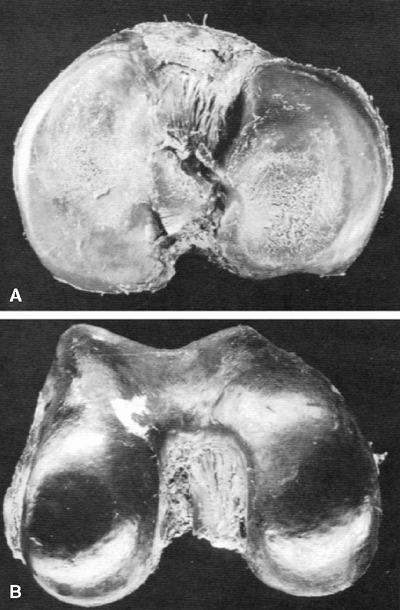 |
Figure 3-4 A, Gross photograph of the tibial side of a knee joint obtained at necropsy from a 55-year-old man. This photograph was made with use of ultraviolet light, which provides much more surface detail. Note the fibrillation on both the medial and lateral sides, especially prominent in the areas not covered by the meniscus. B, Corresponding femoral surfaces, also photographed with ultraviolet light. Note the lack of fibrillation on this joint surface. In the early stages of degenerative joint disease, more often than not, fibrillation is seen on only one of the opposed articular surfaces. This is in marked contrast to eburnation, in which both of the opposed surfaces are affected. |
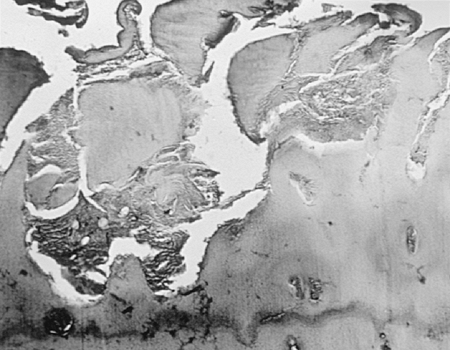 |
Figure 3-5 Femoral head of adult demonstrates severe fibrillation leading to cracking that extends into tidemark zone. Lateral extension has produced a poorly attached fragment. Resulting defect will be filled by either repair fibrocartilage or ossifying granulation tissue penetrating from the subchondral bone. (Magnification x 50.) |
Early accounts5 noted the increased numbers of chondrocytes adjacent to areas of chondromalacia and the increased affinity of the perilacunar matrix for hematoxylin. More recent studies have confirmed an increase in the synthetic activities of chondrocytes, including collagens23 and degradative enzymes,24 in these zones. Although apoptosis of chondrocytes in osteoarthritis has been documented,25 there is an obvious increase in numbers of chondrocytes characterized by multiple cells per lacuna adjacent to zones of fibrillation and chondromalacia (Fig. 3-7). Notwithstanding that metaplastic chondrocytes in osteoarthritis might be capable of migration to produce this appearance,26 the preponderance of evidence supports focal mitotic activity as the basis of the clones. 27 The proliferating chondrocytes associated with erosive lesions have been demonstrated to contain unstable DNA with tetraploidy.28 Other studies have identified trisomy 7 as a characteristic acquired somatic mutation in osteoarthritic synovia and cartilage.29 Enlarged, phenotypically altered chondrocytes are also seen, particularly in the deeper zones (Fig. 3-8). These cells have been shown to produce type X collagen, normally associated with the hypertrophic zone of epiphyseal cartilage.30
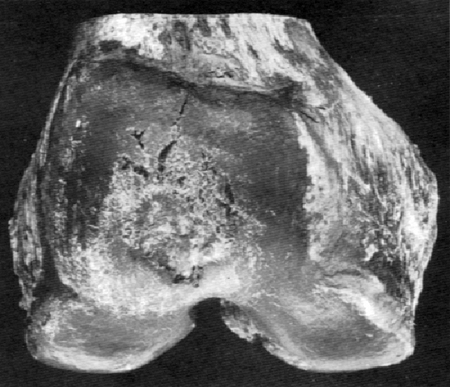 |
Figure 3-6 Gross photograph made with ultraviolet light demonstrates an erosion on the femoral side of the patellofemoral joint. Such lesions are common in older individuals. Note that there is not only fibrillation but also some cracking of the cartilage. |
The proliferation of chondrocytes has long been associated with the perilacunar dissolution phenomenon known as Weichselbaum lacunar resorption. This change (Fig. 3-9) was once identified as relatively specific for early osteoarthritis but is also seen in rheumatoid arthritis. It is best regarded as a histologic expression of degrading of cartilage matrix by chondrocytes responding to cytokines, recently described quanitatively.31
P.55
Suppression of anabolic activities, particularly those of matrix protein synthesis, has been demonstrated in upper zones of osteoarthritic cartilage.32 Secretion of several matrix metalloproteinases is increased over that in normal cartilage,33 particularly in response to tumor necrosis factor- (TNF- )33 or interleukin-1a.33 Consequent release of type II collagen fragments correlates with the progression of osteoarthritis.34,35
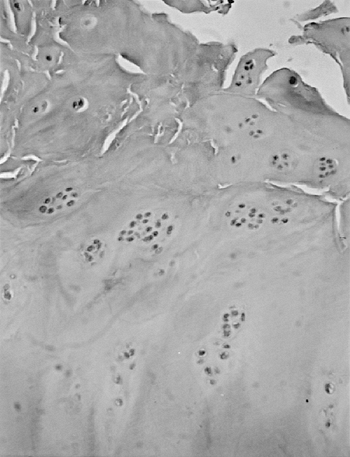 |
Figure 3-7 Photomicrograph from osteoarthritic proximal tibial articular surface demonstrates chondrocyte proliferation adjacent to area of fibrillation. (Magnification x 50.) |
In osteoarthritis the original hyaline articular cartilage is partially replaced in progressive disease by a repair cartilage (Fig. 3-10). This cartilage often overlies a deeper zone of original articular cartilage (Fig. 3-11). Frequently, this repair cartilage has the histologic and histochemical characteristics of fibrocartilage, containing obvious broad collagen fibers and reduced amounts of matrix proteoglycans compared with native hyaline articular cartilage. In advanced osteoarthritis, none of the original hyaline cartilage may remain (Fig. 3-12). Although type II collagen continues to be produced36 in osteoarthritic repair cartilage, a class switch to type I collagen23 has been demonstrated in more advanced osteoarthritis37 as well as marked loss of type VI collagen from the perilanucunar matrix.38
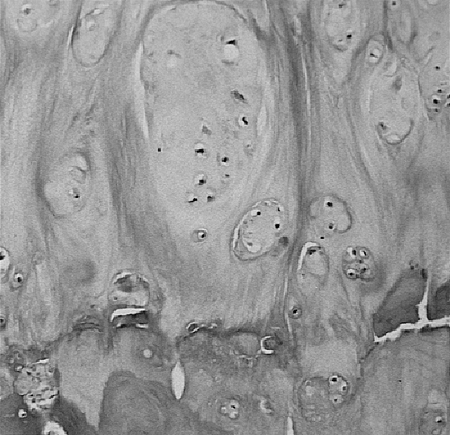 |
Figure 3-8 Enlarged chondrocytes in deep radial zone have proliferated and are undergoing hypertrophy followed by enchondral ossification in the zone of calcified cartilage. This contributes to thinning of the articular cartilage. (Magnification x 50.) |
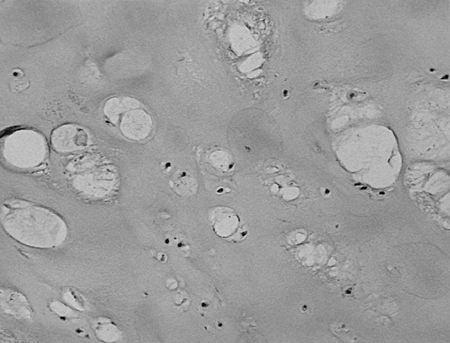 |
Figure 3-9 Chondrocytic resorption of surrounding matrix in osteoarthritis, which is occurring even at a distance from any zones of fibrillation or repair. This is evidence of cytokine stimulation of degradative enzyme release. (Magnification x 50.) |
 |
Figure 3-10 Gross view of osteoarthritis of knee joint in an elderly man. Menisci have been removed to enhance visibility. Femoral condyles demonstrate roughened surface composed of repair fibrocartilage. This is especially prominent at joint margins (m). Intercondylar groove and corresponding area on tibia demonstrate some eburnation (e). Joint mouse (arrow) corresponds to defect (d) in tibial surface. |
P.56
The cartilaginous surface of osteophytes is covered by a mixture of fibrocartilage and fibrous tissue, at times overlying a residual area of hyaline cartilage and original subchondral bone (Fig. 3-13). For these reasons, biochemical and molecular studies of osteoarthritic cartilage frequently produce heterogeneous results, depending on the admixture of native cartilage, repair cartilage, and fibrocartilage in the specimens examined.
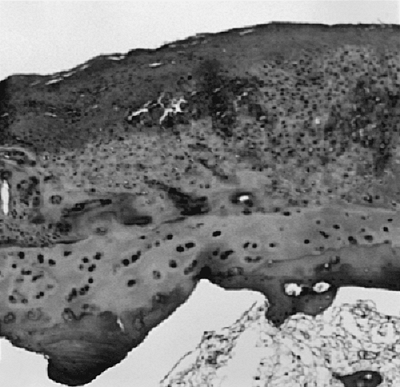 |
Figure 3-11 Cellular repair fibrocartilage on surface of joint. Note underlying residual hyaline articular cartilage. (Magnification x 50.) |
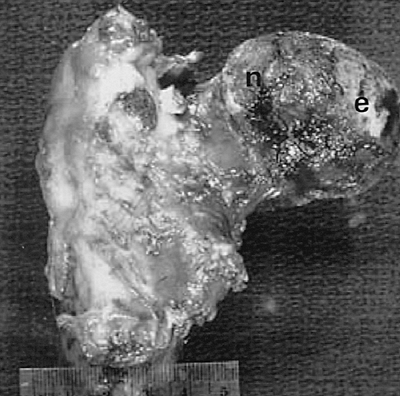 |
Figure 3-12 Gross view of femoral head and neck removed at autopsy in 62-year-old man with severe bilateral hip osteoarthritis. No residual hyaline articular cartilage remains. Margins of joint demonstrate bosselated nodules of fibrocartilage (n) overlying marginal buttress osteophytes. An area of eburnation (e) is present on the superolateral weight-bearing surface. |
The tidemark, as seen in Fig. 3-1, is defined as an undulating hematoxyphilic line marking the boundary of the zone of calcified cartilage with the deep radial zone of articular cartilage. In osteoarthritis, this line becomes extensively reduplicated, often with irregular projections of calcified cartilage into the basal articular cartilage (Fig. 3-14). Several types of degenerative change in the zone of calcified cartilage have been reported39 in association with osteoarthritis.
 |
Figure 3-13 Formation of an osteophyte. New cartilaginous surface composed of cellular repair cartilage (n) and subchondral bone (b) lies over old hyaline cartilaginous surface (o), which will eventually be eliminated by bidirectional enchondral ossification. (Magnification x 50.) |
 |
Figure 3-14 Remodeling changes of calcified cartilage and osteochondral junction in osteoarthritis as shown by a Bodian protargol impregnation stain. Tidemark (t) is tortuous with extensions of calcified cartilage into deep radial zone (r). Chondrocytes of calcified cartilage are hypertrophic. Tongues of bone (b) extend into the calcified cartilage. (Magnification x 50.) |
P.57
Degenerative changes in the zone of calcified cartilage, including reduplication and advancement into the basal noncalcified articular cartilage, occur early in the course of osteoarthritis, often apparent in underlying areas with only minimal fibrillation. As a result, considerable speculation remains as to the possible role of changes in the calcified cartilage in initiating or promoting osteoarthritis.40,41 Advancement of the vascularized subchondral ossification front could contribute to thinning of the articular cartilage, thereby leading to progression of osteoarthritis. It may also be related to the re-expression of vascular endothelial growth factor by chondrocytes noted in an experimental model.42
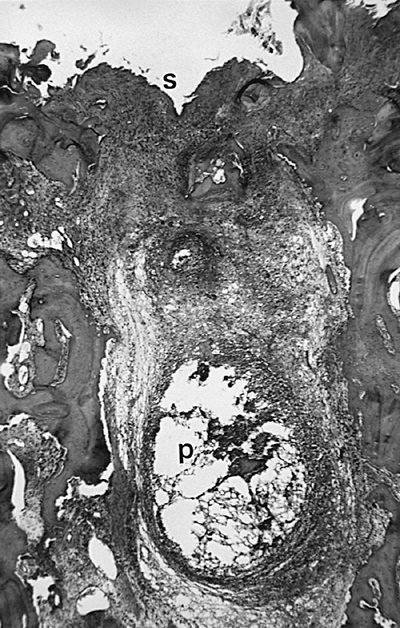 |
Figure 3-15 Established osteoarthritis of femoral head. Fibrocartilaginous surface (s) is breached by a column of granulation tissue extending from underlying subchondral marrow. This is a stage in the eburnation of the joint surface. A small pseudocyst (p) is present. (Magnification x 60.) |
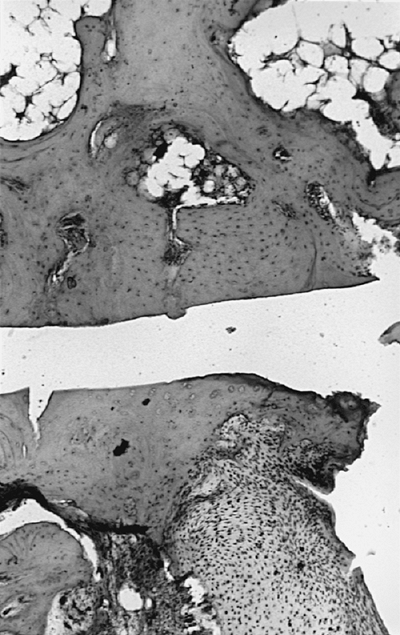 |
Figure 3-16 Eburnation of opposing joint surfaces in interphalangeal joint of elderly woman with generalized osteoarthritis of the nodal type. Articular cartilage has been replaced by sclerotic bone. (Magnification x 50.) |
Subchondral Bone in Osteoarthritis
As heretofore discussed, remodeling of the bone-cartilage interface occurs early in the course of osteoarthritis, often in areas underlying fibrillated articular cartilage. Several other forms of remodeling also occur in the subchondral bone, either directly beneath the weight-bearing surface or at the margins of the joint. The latter constitute the osteophytes so characteristic of primary osteoarthritis. Proliferation of bone in the subchondral areas leads to remodeling of the bone-calcified cartilage interface with vascular incursion into the articular cartilage.8,43 Eventually, spikes of granulation and fibrous tissue reach the joint surface. Enchondral ossification, together with intramembranous ossification of fibrovascular tissue penetrating the cartilaginous surface (Fig. 3-15), produces thinning of cartilage44 and eventual exposure of smooth, dense bone on the articular surface (Fig. 3-16). This phenomenon, known as eburnation, is characterized not only by dense bone at the articular surface, but also by marked sclerosis of the subchondral cancellous bone. This change can be observed while some cartilage remains on the joint surface but is most marked when cartilage is totally absent as suggested by quantitative studies.45 At times, the resulting dense bone demonstrates secondary osteonecrosis characterized by small zones of devitalized bone with empty lacunae devoid of viable osteocytes. Although usually appreciated only on microscopic examination, the zones are large enough at times to be visible grossly (Fig. 3-17). The appearance is distinctly different from primary osteonecrosis (avascular necrosis), in which a subchondral bony sequestrum underlies viable articular cartilage. The
P.58
role of this secondary osteonecrosis in promoting collapse of the articular surface (Fig. 3-18) in advanced osteoarthritis has been the subject of discussion for years. The pathogenesis of this condition is presumably related to occlusion of minute intramedullary arteries. At any rate, it is common, occurring in up to14% of femoral heads resected for severe osteoarthritis.46 In addition, some patients with osteoarthritis develop sterile subchondral inflammatory microabscess-like accumulations.47 The pathogenesis of these zones is uncertain, but they may contribute to collapse associated with rapidly progressive variants of osteoarthritis.
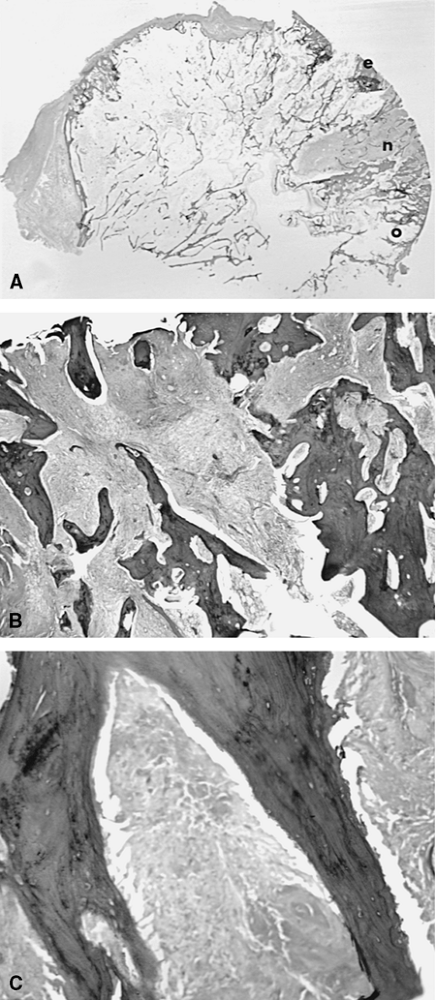 |
Figure 3-17 Osteoarthritic femoral head with secondary osteonecrosis. A, Whole mount coronal section shows area of eburnation (e), adjacent superficial subchondral bone necrosis (n), and osteophyte (o). (Magnification x 2.) B, Medium-power photomicrograph of same slide clearly shows devitalized bone and bone marrow. (Magnification x 50.) C, Higher power view shows absence of nuclei in bone and bone marrow. This type of superficial necrosis must be distinguished from primary avascular necrosis. (Magnification x 300.) |
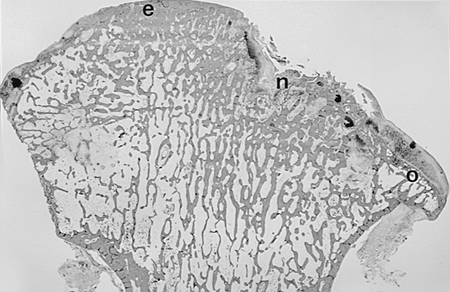 |
Figure 3-18 Whole mount coronal section of femoral head from adult man with long-standing osteoarthritis. Eburnation of weight-bearing surface (e) borders zone of superficial secondary osteonecrosis (n) that has collapsed. Rapid progression can occur under these conditions. Note osteophyte (o) adjacent to collapse. (Magnification x 2.) |
 |
Figure 3-19 Photomicrograph from femoral head with osteoarthritis. Low-power view shows defect (d) in surface that has penetrated into subchondral bone marrow. Pseudocyst (c) filled with myxoid material lies beneath defect. (Magnification x 50.) |
Microfractures of subchondral bone trabeculae also have a potential role in the provocation and progression of osteoarthritis. Subchondral trabecular fractures must be distinguished from microfractures of the calcified cartilage (Fig. 3-3) and bony plate.48 These allow vascularization of the cartilage, and when communicating with the surface, provoke intra-oseous pseudocyst formation (Fig. 3-19). Vascular invasion of the basal calcified cartilage may lead to ossification and resulting thinning of the cartilage, increasing shear stresses.49 Microfractures are easily demonstrated in load-bearing zones of subchondral bone,50 but they are decreased in osteoarthritis.49,51 This suggests the remodeling of bone into thicker, less compliant trabeculae52 may be the primary event in producing
P.59
cartilage damage rather than microfractures themselves. Remodeling of bone in osteoarthritis has been confirmed by both direct observation and fractal analysis.53
 |
Figure 3-20 Whole mount coronal section of femoral head with established osteoarthritis. Eburnation (e) borders large pseudocyst (arrows) surrounded by reactive bone. Marginal osteophytes increase apparent diameter of femoral head. (Magnification x 1.5.) |
Another characteristic of progressive osteoarthritis is the formation of subchondral pseudocysts (Fig. 3-20). These are especially prominent in both the acetabular and femoral components of the hip joint. These spaces usually contain fluid and fibromyxoid material with occasional fragments of nonviable bone or cartilage. When mature, the pseudocyst is surrounded by a thin rim of reactive bone (Fig. 3-20). Minute gaps penetrating through the subchondral plate and articular cartilage are commonly seen at the apex of these pseudocysts, especially if serial sections are obtained (Fig. 3-19). The most attractive theory regarding pseudocysts is that the intrusion of intra-articular pressure through osteocartilaginous discontinuities produces local necrosis leading to the rarefied zones.54 This is also supported by the observation that the pseudocysts tend to disappear as osteoarthritis progresses to an advanced state with the joint surface being replaced by either a solid layer of eburnated bone (Fig. 3-16) or repair fibrocartilage (Fig. 3-21). Enchondral bone formation is characteristic of progressive osteoarthritis. This may take the form of enchondral bone formation at the base of articular cartilage (Fig. 3-13) or at the margins of the joint.55 The latter type, when fully developed, leads to osteophytes (Fig. 3-22). These bony outgrowths characteristically appear in areas away from the major weight-bearing zones. Large osteophytes are particularly characteristic of primary osteoarthritis of the hip joint; their absence suggests that osteoarthritis, if it is present, has resulted from prior inflammatory lysis of cartilage resulting in secondary rather than primary osteoarthritis (Fig. 3-23). Another characteristic phenomenon is the presence of osteochondral loose bodies known as joint mice. These fragments are composed of proliferative cartilage surrounding devitalized bone (Fig. 3-24). Their origin from the disordered joint surface is proved by the presence of corresponding defects left by their avulsion (Fig. 3-4). Whether the primary factor in their genesis is underlying subchondral necrosis, disordered enchondral ossification, or mechanical avulsion is difficult to prove. The primacy of cartilage versus bone alterations in the provocation of osteoarthritis remains debatable. However, there can be no doubt that the latter stages are characterized by marked proliferative and degenerative changes of subchondral and marginal bone.
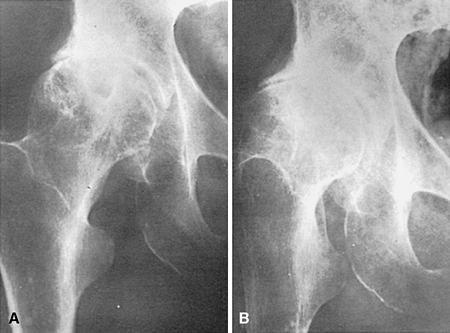 |
Figure 3-21 A, Clinical radiograph of a patient with advanced osteoarthritis is characterized by loss of the joint space and extensive cyst formation both on the acetabular side of the joint and in the femoral head. This patient was observed without treatment for 31/2 years after this radiograph was taken. At that time, another radiograph of the hip was taken B, in which it can be appreciated that there is a diminution of the cysts in both the acetabulum and the femoral head, an apparent decrease in the sclerosis, and an increase in the joint space. |
Periarticular Soft Tissues in Osteoarthritis
Current theories focus on osteoarthritis as a disorder resulting from aberrant responses of articular cartilage and subchondral bone to cytokines produced both systemically and locally.56,57 Inflammatory aspects of osteoarthritis have, until recently, attracted less interest.58,59 This should not obscure the fact that some degree of synovial villous
P.60
hypertrophy accompanied by fibrosis (Fig. 3-25) is common in osteoarthritis.60 It is important to distinguish the stage of any particular case of osteoarthritis before ascribing causation to the synovial inflammation. This is one reason that autopsy hip joints with comparatively mild osteoarthritis do not reflect the synovial pathology of surgical specimens from hip replacement.2 The synovial response in osteoarthritis has been postulated to evolve from an early exudative stage characterized by intimal hyperplasia to a late fibrotic stage.60 Most studies of synovium in early osteoarthritis have shown that the synovitis is characterized histologically by a mild infiltrate composed primarily of lymphocytes and mononuclear cells61 and that the infiltrates differ both qualitatively and quantitatively from those associated with rheumatoid arthritis.62 Differences include greater overall cellularity61 and numbers of macrophages,63 plasma cells, and CD4 T cells64 in rheumatoid arthritis as opposed to osteoarthritis. Although the cellular and molecular character of the infiltrate in osteoarthritis clearly differs from that in rheumatoid arthritis, the presence of inflammation is undeniable. In one study, higher levels of the inflammatory marker C-reactive protein in serum of women predicted progression of early knee osteoarthritis.65 Although cells with CD4 phenotype are more plentiful in rheumatoid arthritis,64,66 cells with CD16+/56 phenotype indicative of natural killer cell activity are actually more numerous in osteoarthritis synovium.66 Mast cells, with possible roles in mediating inflammation and bone destruction, are increased in the synovium in osteoarthritis and in one study were significantly more numerous than in rheumatoid synovium.67 Other studies have examined the relationship of low-grade synovial inflammation in osteoarthritis to cytokine production.68 Chondrocytes responding to chronic cytokine stimulation may well produce the degradation of matrix macromolecules, including type II collagen, so characteristic of progressive osteoarthritis.34,35
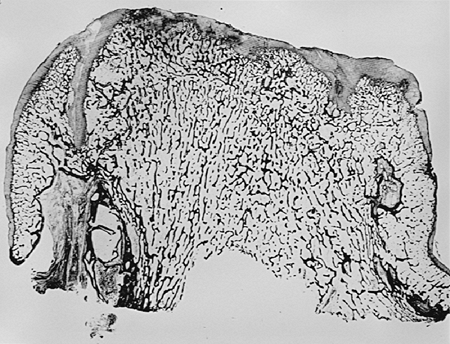 |
Figure 3-22 Whole mount coronal section of femoral head of adult woman with advanced osteoarthritis. Weight-bearing portion of joint is deformed, flattened, and covered with repair cartilage. Large bilateral osteophytes are present. (Magnification x 1.5.) |
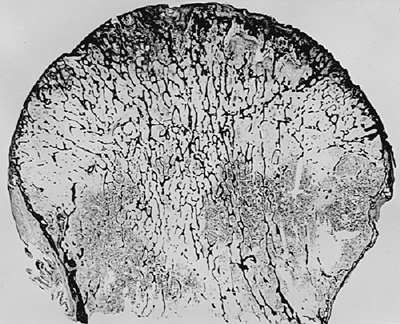 |
Figure 3-23 Whole mount coronal section of femoral head of adult woman with advanced secondary osteoarthritis after rheumatoid arthritis. Surface shows eburnation accompanied by underlying bony sclerosis. Note absence of osteophytes. (Magnification x 2.) |
Many cases of advanced osteoarthritis are characterized by joint detritus consisting of cartilaginous or osteocartilaginous fragments embedded in the synovium.69 This resulting detritic synovitis (Fig. 3-26) not only induces inflammation but stimulates production of degradative enzymes and cytokines by synovial macrophages. Detritic synovitis also creates the possibility that autosensitization to cartilage structural proteins may generate an immune response in osteoarthritis. In this regard, circulating proteoglycans have been demonstrated in the sera of patients with osteoarthritis.70
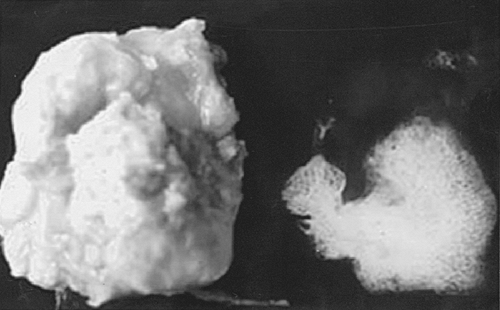 |
Figure 3-24 Gross appearance and matching radiograph of osteocartilaginous loose body (joint mouse). Nodular proliferative cartilage on surface is characteristic, as is the faint calcification seen in the cartilage at upper right of radiograph. |
The immunopathology of osteoarthritis is equally complex. Deposits of immunoglobulin are definitely present in the superficial zone of cartilage in osteoarthritis.71 Although the possibility exists that antibody formation is a response to matrix damage or detritic synovitis, autoantibodies are also seen in early osteoarthritis suggesting a role in provocation.72
Synovial inflammation in osteoarthritis cannot be separated from the role of crystal-induced inflammation. In osteoarthritis, both calcium pyrophosphate dihydrate
P.61
(CPPD) and basic calcium phosphate (BCP) have been identified in synovium, cartilage, and synovial fluid.73 Crystals stimulate synthesis of interleukin-1, which causes synovial cells to release proteases capable of destroying cartilage matrix. Studies implicate TNF- in this process74 as well. The role of crystals in the genesis of inflammation in osteoarthritis is part of the larger question of the overall contribution of chondrocalcinosis to osteoarthritis.73 The relationship of chondrocalcinosis in general to osteoarthritis has been the subject of continuing debate. It has been proposed that BCP crystals are correlated with osteoarthritis,75 whereas CPPD crystals are associated with aging. Nevertheless, about half of the knees treated surgically for osteoarthritis after the age of 68 years have meniscal chondrocalcinosis, a sixfold increase above that of an age- and sex-adjusted postmortem population.76 Chondrocalcinosis is much less frequent, however, in femoral heads removed for fracture. Deposition of CPPD in the menisci ordinarily does not generate an inflammatory reaction,16 unlike synovial crystal deposition.
 |
Figure 3-25 Photomicrographs of synovial tissue obtained from an osteoarthritic joint. A, Typical villous synovitis is characterized by fibrous projections lined by hyperplastic synovial cells. (Magnification x 30.) B, Higher magnification shows scattered lymphocytes and plasma cells in subsynovial tissue. (Magnification x 500.) |
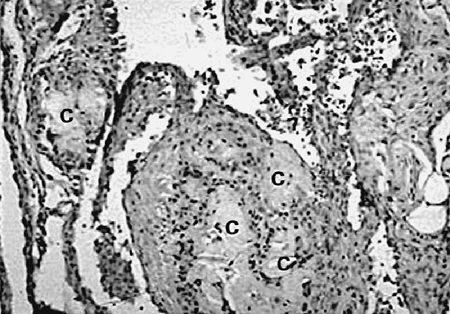 |
Figure 3-26 Detritic synovitis resulting from shards of abraded articular cartilage (C) impacted in the synovium. This is a feature of destructive, advanced osteoarthritis. (Magnification x 200.) |
Periarticular soft tissues other than synovium are also involved, either directly or indirectly, in osteoarthritis. Barely visible or microscopic tears in capsular tissues are commonly seen. The ligaments and menisci of the knee joint develop fraying and cracking not unlike that of lesions of articular cartilage.16 Substantial clinical evidence associates prior meniscectomy with subsequent osteoarthritis,77 but there is a strong correlation between osteoarthritis of the knee and generalized osteoarthritis.78 This would suggest that meniscectomy accentuates osteoarthritis in a genetically predisposed population.
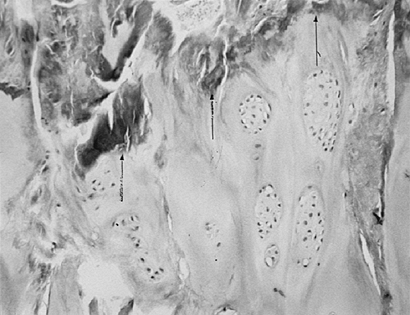 |
Figure 3-27 Congo red stain of elderly male patient with osteoarthritis demonstrates darkly stained deposits of amyloid (arrows) in cartilage. Note proliferation of chondrocytes. (Magnification x 50.) |
Joint capsular tissues are also the site of other degenerative phenomena in osteoarthritis. These include lipochondral degeneration in capsular tissues of the hip that have undergone previous nodular chondroid metaplasia.79 This change was not associated with CPPD deposition. However, calcific degeneration of the ligamentum teres is common in osteoarthritis of the hip. Deposits of the amyloid-associated protein type are also common (Fig. 3-27) in joint capsule and articular cartilage in osteoarthritis,80
P.62
but they also occur in joints of normal older individuals, and are strongly associated with concomitant deposition of CPPD crystals.81 Periarticular fibrosis is also common and is especially marked in the subsynovial retinaculum in advanced osteoarthritis.60 In the reverse of the situations described before, numerous connective tissue disorders including osteogenesis imperfecta types I and III,82 Ehlers-Danlos syndrome (EDS) type VII,83 and Larsen syndrome (osteochondrodysplasia with joint laxity) are associated with premature secondary osteoarthritis related to joint hypermobility. These are but one of several forms of heritable generalized osteoarthritis.
Variants of Osteoarthritis
The pathologic lesions more or less common to the induction and progression of osteoarthritis give ample evidence for the complexity of the disorder. This problem is exacerbated by the numerous variations on the central themes of the disease. These variations may be classified by one of several nosologic arrangements, such as generalized versus localized, primary versus secondary, and heritable versus acquired, or by some combination of such systems. For purposes of this discussion, secondary osteoarthritis is defined as that which develops in the setting of a known antecedent condition, which may be one of any number of disease states. Regardless of the classification employed, several distinct varieties have emerged on the basis of characteristic clinical and pathologic findings.
Primary Generalized Osteoarthritis
Primary generalized osteoarthritis is a variant of osteoarthritis characterized by a preponderance in middle-aged or older women and by Heberden node formation as well as carpometacarpal and knee involvement. Most cases have clinical signs of articular inflammation. Proliferation of adjacent bone to form osteophytes is the most conspicuous pathologic finding, and this apparently begins prior to destruction of the surface cartilage.84 Progression of articular cartilage erosion to eburnation is not as common as in weight-bearing joints. Heberden and Bouchard nodes are actually osteophytes in a characteristic location (Fig. 3-28) and are not a unique pathologic process. For many years, debate has continued as to whether osteoarthritis of the hip and knee joints is more frequent in patients with generalized osteoarthritis than in those without it. Notwithstanding the obvious differing contributions that occupation and obesity might bring to the hands versus the hips,85 most epidemiologic studies have affirmed a positive relationship,86 as with bilateral knee involvement.78,87 However, no unique pathologic features distinguish primary hip and knee osteoarthritis in patients with hand disease from those without it.
The familial tendency of generalized osteoarthritis has been recognized for decades, although workload on the hands may contribute to the full expression of the disorder.88 More recent investigations have linked a region of chromosome 2q23-3589 to osteoarthritis of the hand. Familial aggregation with evidence for a mendelian recessive inheritance with a residual multifactorial component has been recently reconfirmed.90
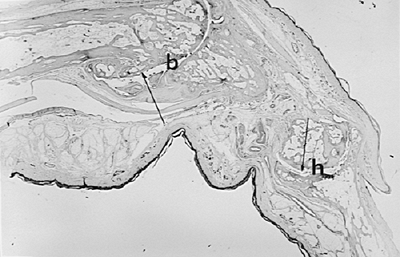 |
Figure 3-28 Whole mount coronal section of finger of elderly woman with generalized osteoarthritis. Heberden (h) and Bouchard (b) nodes are seen as osteophytes (arrows). (Magnification x 2.) |
Osteoarthritis with Heritable Collagen Defects
During the past decade, several kindreds have been reported with precocious osteoarthritis associated with various defects in type II collagen synthesis. In some instances, mild spondylodysplasia is associated with osteoarthritis.91,92 Some families have point mutations,91,92 whereas others suggest aberrancies in a promoter or intron region.93 Another condition, Stickler syndrome (hereditary arthro-ophthalmopathy), is likewise associated with structural abnormalities in type II collagen.94 The peripheral joints in these kindreds show marked erosion of cartilage. Electron microscopy in one spondylodysplasia kindred demonstrated parallel lamellar arrays of fine collagen fibrils in a case involving an arginine-cysteine point mutation.95 Linkage analysis in families with early onset osteoarthritis demonstrates locus and allelic heterogeneity in three different collagen genes.96 Thus, the genetic predisposition to the much more common types of primary osteoarthritis, although definite, appears to reside in several genetic loci.97
Endemic Osteoarthritis
Unlike some primary generalized or hereditary collagen defect-associated osteoarthritis variants, these are composed of cohorts primarily united by geography. At this time, several distinct types have been described clinically and pathologically. These include Kashin-Beck disease (endemic osteoarthrosis deformans) found in certain zones of northern China, Tibet, North Korea, and Siberia;98 Mseleni disease found in South Africa's Zululand region;99 and Handigodu disease found in southern India.100 These share features in common that distinguish them from generalized
P.63
osteoarthritis of the usual sort. These include occurrence in young people of both sexes and marked proliferative tendencies of bone and cartilage. In Kashin-Beck disease, the early changes consist of zonal necrosis of both articular and epiphyseal chondrocytes,101 beginning in childhood and progressing to profound deformity, especially in the distal extremities. One study described decreased vascularization of the proximal cartilage end plate,102 and increased apoptosis of chondrocytes has also been described.103 Although selenium deficiency has been proposed as the agent in the disorder,104 concomitant iodine deficiency may well be the evocative factor.105 In addition, mold toxins have also been implicated,106 and one, fulvic acid, has been shown to produce a Kashin-Beck-type picture in selenium-deficient mice107 and to disturb oxidative metabolism of cultured chondrocytes.108 Mseleni disease, like Kashin-Beck disease, is polyarticular, but the hip is particularly severely affected. Pathologic studies109 of resected femoral heads have demonstrated a rough articular surface composed of degenerated and regenerated articular cartilage rather than eburnated bone. Interestingly, the disorder is also associated with pathologically demonstrated osteomalacia.110
Although familial aggregation of Mseleni osteoarthropathy is present, molecular studies have shown no relationship to the histocompatibility complex (HLA) system; however, a mutation in type II collagen might be involved in some cases.99 Heterogeneity is further suggested by the observation that some patients with Mseleni disease also have a dwarfing spondylodysplasia.111 Handigodu disease100 shows many pathologic similarities to Mseleni osteoarthropathy but demonstrates an autosomal dominant pattern of inheritance. These relatively obscure diseases may yet offer information applicable to more common types of joint disease.
Secondary Osteoarthritis Variants
Numerous antecedent conditions result in secondary osteoarthritis of polyarticular, oligoarticular, or monoarticular patterns. These conditions are summarized in Table 3-1. A variety of mechanisms are involved, but all eventually lead to cartilage erosion and bone remodeling characteristic of osteoarthritis. Generally speaking, the more tendency to inflammation shown by the evocative disorder, the less prominent will be the bone remodeling manifested as osteophytes. In other circumstances, specific infiltrates, such as urate in gout or hemosiderin in hemophilic arthropathy, may give mute testimony to the origin of the secondary osteoarthritis. In others, the profoundly degenerated end-stage joint may pose a diagnostic dilemma as to the antecedent condition. In some circumstances, such as CPPD deposition disease, distinguishing primary osteoarthritis associated with CPPD deposition from secondary osteoarthritis can be almost impossible, especially in the knee joint.112
TABLE 3-1 PATHOGENETIC CLASSIFICATION OF SECONDARY OSTEOARTHRITIS | |||||||||||||||||||||||||||||||||||||||||||
|---|---|---|---|---|---|---|---|---|---|---|---|---|---|---|---|---|---|---|---|---|---|---|---|---|---|---|---|---|---|---|---|---|---|---|---|---|---|---|---|---|---|---|---|
|
Osteoarthritis with Joint Hypermobility
A number of heritable disorders of connective tissue result in abnormal joint laxity, often with recurrent dislocations. Precocious osteoarthritis associated with erosion of articular cartilage customarily results. EDS is a heterogenous disorder frequently involving joint hypermobility. Two types are definitely associated with osteoarthritis. These include EDS type VII due to mutations in the type I collagen a2 chain113 and EDS due to mutations in the gene for tenascin-X. 114 Although osteoarthritis of multiple major joints is the rule, congenital hip dislocation is also encountered,115 potentially leading to severe deformity in that joint resembling that seen in cerebral
P.64
palsy. Osteogenesis imperfecta types I and III are associated with mutations in the 1(I) and 2(I) collagen chains, respectively.116 In addition to osteoarticular deformity due to recurrent fractures, there is also ligamentous laxity. The combination results in early onset osteoarthritis. Ligamentous laxity is also the cause of the precocious osteoarthritis in Marfan syndrome. In Larsen syndrome (osteochondrodysplasia with joint laxity), multiple congenital dislocations also lead to premature osteoarthritis.117 Major weight-bearing joints are particularly affected.
Osteoarthritis with Heritable Structural Abnormalities of Cartilage
A number of heritable conditions result in structurally abnormal articular cartilage or overall joint morphologic features. Osteoarthritis with variable degrees of generalization results. Achondroplasia, the most common form of short-limbed dwarfism, eventuates in severe osteoarthritis of the hips by early middle age with other joints variably affected. Numerous types of spondylodysplasias eventuate in osteoarthritis as well. The existence of kindreds with spondylodysplasias and specific mutations in type II collagen has been discussed previously. Stickler syndrome, an infantile presentation of spondylodysplasia with ocular abnormalities, is also associated with type II collagen mutations. Multiple epiphyseal dysplasias are forms of dwarfism not associated with spinal involvement that also culminate in severe osteoarthritis in weight-bearing joints in early adult life. Several forms of autosomal dominant multiple epiphyseal dysplasia have been described,118 although less than half have an identified mutation.119 The femoral head is the specimen most often available for pathologic study, and these specimens usually demonstrate marked eburnation and sclerosis without conspicuous osteophytes. Diastrophic dwarfism is another form of dwarfing chondrodysplasia resulting in a twisted appearance of the long bones. Because patients survive for normal life spans, severe degeneration of major joints occurs. Bilateral osteoarthritis of the hips requiring joint replacement is the rule. In cases of chondrodystrophic epiphyseal dysplasia, the small size of the femoral head should suggest that some variant of secondary osteoarthritis involving such a syndrome may be involved. Caution in diagnosis is required because similar small size coupled with severe osteoarthritis can also be seen in congenital hip dysplasia and Still disease.
Ochronotic Arthropathy. Another variant of osteoarthritis develops in patients with alkaptonuria, an autosomal recessive disorder resulting in a deficiency of homogentisic acid oxidase. Polymers of homogentisic acid accumulate in connective tissues, particularly cartilage, producing a bluish black discoloration and altering the water-binding properties of the matrix protein-polysaccharides. The resulting fragility of articular and intervertebral cartilage leads to precocious erosion120 and, in the case of the diarthrodial joints, severe detritic synovitis. A type of generalized secondary osteoarthritis is the result. Unlike primary osteoarthritis, remodeling and osteophyte formation are not prominent. The pathogenesis of the disorder is complex. Calcium pyrophosphate crystals are frequently identified in ochronotic synovium, and homogentisic acid itself induces chondrocyte DNA damage through an oxidative process.121 Unlike many forms of secondary osteoarthritis due to structurally abnormal cartilage, synovial inflammation due to joint detritus (and perhaps CPPD deposition) is a prominent feature.
Hemophilic Arthropathy. Hemophilic joint disease shares many common pathologic features with osteoarthritis.122 These include early erosion of articular cartilage with accompanying bone remodeling leading to eburnation, subchondral sclerosis, and marginal osteophyte formation. Several additional distinctive findings are characteristic of hemophilic arthropathy. One such feature is the large quantity of hemosiderin pigment deposited in synovium in both intracellular and extracellular sites. Synovium is often brownish red but does not display the marked hyperplasia seen in pigmented villonodular synovitis, although invasive pannus may extend from the synovium during early stages of the hemophilic arthropathy (Fig. 3-29). Subchondral pseudocysts are usually prominent and, unlike those in primary osteoarthritis, contain hemosiderin pigment deposited in macrophages. Ankylosis, extremely rare in osteoarthritis, is not uncommon in late cases of hemophilic arthropathy. Joint contractures are also common and may be related to concomitant muscle injury from the hematomas. Interestingly, a single hemarthrosis of a traumatic origin does not ordinarily result in subsequent secondary osteoarthritis unless the joint surface or neighboring bone is fractured. Thus, recurrent exposure of synovium and cartilage to hemorrhage, perhaps under pressure, is necessary to produce chronic degenerative disease of hemophilic type.123
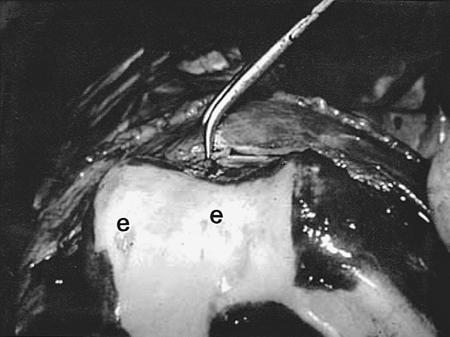 |
Figure 3-29 Gross photograph of knee joint with early hemophilic arthropathy. Vascularized pannus has extended over articular cartilage of femoral condyle. Erosions of cartilage (e) are already present. |
Osteoarthritis with Acquired Structural Abnormalities
Numerous acquired structural abnormalities result in severe secondary osteoarthritis. Among the more common are avascular necrosis,124 trauma (especially that involving
P.65
the articular surface),125 developmental dysplasia of the hip (formerly congential hip dysplasia),126 and Paget disease.127 Although diabetes mellitus is associated with a wide variety of connective tissue disorders, many of which affect the joints,128 it is more difficult to demonstrate a direct causal relationship to osteoarthritis. Although some older studies have shown an increased prevalence of osteoarthritis among adult diabetics,129 others have not linked osteoarthritis with impaired glucose tolerance.130 Any association of osteoarthritis with diabetes mellitus would be extremely complex owing to confounding variables, including serum insulin and growth hormone levels, possible neurogenic acceleration, direct cartilage damage from glycosylation,131 and the contribution of associated obesity.132 Even if diabetes is removed as a comorbid factor, women with full-body radiographically defined osteoarthritis show decreased survival,133 indicating that viewing any variant of generalized osteoarthritis as a joint disease devoid of serious systemic relationships is questionable.
Although uncommon, acromegaly uniformly results in severe generalized osteoarthritis.134 Overgrowth of the ends of long bones in the disorder involves a combination of factors, including thickening of articular cartilage, enhanced enchondral bone formation in the osteochondral junction, and exuberant osteophyte formation. The terminal phalanges develop an arrowhead configuration because of these processes, but the appearance is dissimilar to generalized nodal osteoarthritis. The major weight-bearing joints are affected as well. In contrast to primary osteoarthritis, the cartilage is increased rather than decreased in thickness with marked fibrillation and cracking. Cellularity of the cartilage is increased, and enchondral ossification is usually prominent (Fig. 3-30). The possible relationship of acromegalic arthropathy to osteoarthritis in adult-onset diabetes mellitus is interesting because both groups of patients have elevated serum growth hormone levels,135 as do patients with diffuse interstitial skeletal hyperostosis, a disorder that is definitely related to type II diabetes.
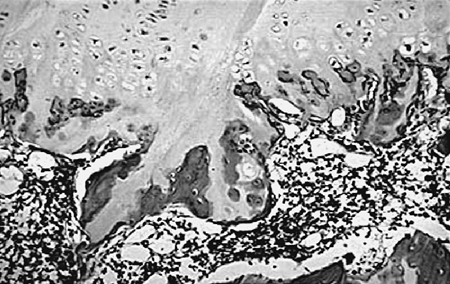 |
Figure 3-30 Photomicrograph of osteochondral junction from femoral head of adult male patient with acromegalic arthropathy and secondary osteoarthritis. Active enchondral ossification is present. Note resemblance of basal cartilage to a growing epiphysis. (Magnification x 75.) |
Some forms of secondary osteoarthritis related to acquired structural abnormalities tend to be localized to a joint or group of joints. The hip joint is the most common site for several such conditions, such as avascular necrosis. Others are entirely limited to the hips. This group includes congenital hip dysplasia, Legg-Perthes disease, and slipped capital femoral epiphysis. Although congenital hip dysplasia in canines is strongly heritable, the situation is far less clear in humans. Some evidence favors a generalized inherited connective tissue defect136,137 but other findings support environmental influences138 in the pathogenesis. Even when repaired early in childhood, severe precocious osteoarthritis often develops (Fig. 3-31). The femoral heads are small, in contrast to those of primary osteoarthritis, and characterized by exuberant repair cartilage. The gross deformation and osteoporosis seen in recurrent hip dislocation associated with cerebral palsy (Fig. 3-32) are even more severe. Some have suggested that subclinical childhood hip dysplasia is responsible for a significant proportion of localized coxarthrosis in mature adults.139 However, one study in women failed to support this concept.140
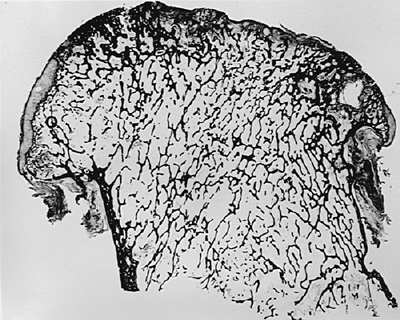 |
Figure 3-31 Whole mount coronal section of femoral head from 28-year-old woman with congenital hip dysplasia (dislocation). Large inferomedial osteophyte (o) is characteristic, as is small size of head compared with diameter of femoral neck. (Magnification x 2.0.) |
Another cause of severe secondary osteoarthritis in the hip joints is Legg-Perthes disease. This disorder is manifested as necrosis of the growth center of the femoral head, usually occurring between 6 and 12 years of age, more commonly in boys; about one in seven cases is bilateral.114 The resulting deformity is a characteristic small, flattened femoral head with bilateral beak-like osteophytes. Similar pathologic change is seen in secondary osteoarthritis due to aseptic necrosis of the hip in childhood from steroid administration, probably because of similar damage to the growth center. Eburnation can occur but is not characteristic. Although the cause of the disorder is obscure, synovitis is a characteristic feature of the early stages.142 Studies have shown an increased prevalence of inherited factor V (Leiden) mutations in Legg-Perthes disease, but this still appears to be comparatively rare143 as a fraction of those affected by the disorder.
The third type of childhood hip disease resulting in localized precocious osteoarthritis is slipped capital
P.66
femoral epiphysis.144 Affected patients are most commonly older male children who are likely to be obese. The disorder results from a fracture through the growth plate. The femoral head then slips inferiorly and posteriorly by variable amounts. Bilaterality is 25% to 40% and is predicted by greater physiologic age of the patient at the time of presentation.145 Complete or total detachment is associated with osteonecrosis and more severe subsequent osteoarthritis. In such cases, the femoral head may be found reattached to the femoral neck at a lower position than normal. In addition to acromegaly, treatment with growth hormone for any of several indications, including chronic renal failure, is a risk factor for this condition.146 One study of a large number of archived adult human skeletons suggested that 8% were involved by some degree of slipped capital femoral epiphysis and that severe osteoarthritis was likely to accompany it.147 This degree of frequency remains to be established in clinical practice.
 |
Figure 3-32 Whole mount macrosection of proximal femur from patient with spastic cerebral palsy and recurrent hip dislocation. Femoral head is small compared with greater trochanter and has a characteristic cuboid appearance. Cartilage is thin and degenerated, but eburnation is absent. (Magnification x 0.9.) |
Osteoarthritis with Crystal Deposition Diseases
The complex biology of the crystal deposition diseases offers insights into the relationship of osteoarthritis to the deleterious effects of chronic low-grade synovial inflammation. All of the major crystal deposition diseases (CPPD, BCP, urate, and oxalate) occur in both primary and secondary forms. Some are clearly heritable.148 The first two are largely diseases of the joints and supporting structures, whereas urate and oxalate arthropathies are systemic diseases that affect the joints, oxalate inconstantly and usually in the setting of chronic renal failure.
Osteoarthritis with Calcium Pyrophosphate Dihydrate Deposition Disease. Osteoarthritis is clearly associated with the primary form of this disorder,73 especially in the elderly, although it is difficult to prove a causal relationship absolutely because both diseases are common in that age group.149 Although hereditary variants of primary chondrocalcinosis due to CPPD deposition certainly exist,150 one family study failed to show an increased risk in siblings of chondrocalcinosis patients.151 However, the condition may be underdiagnosed as serum nucleotide pyrophosphohydrolase activity was significantly elevated in patients with osteoarthritis whether CPPD crystals were demonstrated or not.152 In one study, apoptotic chondrocytes induced by nitric oxide produced pyrophosphate,153 providing a possible common mechanism between osteoarthritis and calcium pyrophosphate deposition disease. In addition, some cases of osteoarthritis clearly have CPPD crystals that are too small to be detected by conventional polarizing microscopy.154 Thus, the association of CPPD crystals with osteoarthritis and their possible role in its pathogenesis may well be underestimated. In addition, secondary CPPD deposition disease occurs in association with several predisposing disease states, including hemochromatosis,155 hyperparathyroidism, ochronosis, Wilson disease,156 acromegaly,134 neuropathic arthropathy,157 and hemophilic arthropathy.122
The CPPD deposition disease associated with hemochromatosis is particularly likely to present as a generalized clinical arthropathy,158 which may imitate rheumatoid arthritis. Genetic analyses have shown increased frequency of hemochromatosis genetic mutations in both apparently ordinary CPPD disposition disease159 and undifferentiated arthritis.160 The extent of CPPD deposition in Wilson disease is less severe. The contribution of CPPD deposition to neuropathic arthropathy can be particularly difficult to discern.157 Calcific deposits in the synovium due to the severe detritic synovitis that results from joint disintegration are one of the hallmarks of the disorder. However, rapidly destructive neuropathic-like changes have been described with both BCP and CPPD deposition.161
Osteoarthritis with Basic Calcium Phosphate Deposition Disease. BCP deposition disease also occurs in both primary and secondary forms. Both extra-articular and intra-articular deposition are recognized and are associated with radiologic chondrocalcinosis. Periarthritis, tendinitis, erosive polyarthritis, or destructive monoarthritis (usually of the shoulder or knee) can be seen in any individual patient.162 Severe local joint destruction may occur. Accurate diagnosis requires specialized techniques because the crystals are less than 100 nm in length and cannot be detected by conventional polarizing microscopy.154 Alizarin red S staining of synovial fluid sediment is a customary method of screening.161 Unlike uncomplicated primary osteoarthritis, increased granulocytes are present in both synovium and synovial fluid in acute BCP deposition disease. The destructive nature of BCP deposition disease may be derived not only from synovial release of enzymes and cytokines, but also by chrondocyte production of
P.67
nitric oxidize synthase.163 This may play a more general role in osteoarthritis as well.164 BCP crystal shedding has also been demonstrated in cases that are clearly primary osteoarthritis.161 Thus, potentiating effects of BCP crystal deposition may well be more common than is customarily realized.
Osteoarthritis with Urate Arthropathy (Gout). As in generalized osteoarthritis, strong hereditary tendencies are present in gout, even in the absence of defined enzymatic defects. However, the increasing incidence is principally related to dietary changes and obesity.165
In susceptible individuals, urate crystals deposited in and around joints evoke periodic attacks of severe acute inflammation, often in the small joints of the toes. Recurrent acute episodes usually lead to severe secondary osteoarthritis in the affected joints similar to that following infections. Such patients have clinical and pathologic features that allow ready separation from localized primary osteoarthritis. These include overwhelming male preponderance; small osteophytes; unusual articular distribution; and presence of urate deposits in synovial fluid, articular cartilage, synovium, joint capsule, and subchondral bone (Fig. 3-33). Deposits within articular cartilage are surrounded by necrotic chondrocytes. Eburnation and subchondral sclerosis are characteristic of advanced lesions, but the osteophytes, unlike those seen in primary osteoarthritis, are usually not prominent. Urate crystals are soluble in neutral buffered 4% formaldehyde, the customary fixative for surgical specimens. Hence, 95% alcohol should be employed for that purpose when urate arthropathy is suspected.166 Viewing of sections from undecalcified tissues under plane-polarized light can then distinguish the leading contenders in the differential diagnosis [calcium pyrophosphate deposition disease (pseudogout), avascular necrosis, and infectious or postinfectious arthropathy] from chronic urate arthropathy. Secondary osteoarthritis from recurrent attacks of acute gout may affect any of the peripheral joints. However, for some unexplained reason, the first metatarsal joint is characteristically involved (podagra). The disease may be diagnosed during the intercritical period between acute attacks by the continuing presence of monosodium urate crystals in the synovial fluid.167 This is more sensitive than aspiration of tophi because most patients with intercritical gout do not manifest them. Urate arthropathy has become a recognized phenomenon in elderly women, often in association with prolonged diuretic therapy.165 These patients are more likely to have gout superimposed on generalized osteoarthritis even to the point of having tophi coexisting with and even deposited in Heberden nodes.168 It is also prudent to remember that CPPD169 and BCP crystals can coexist with those of urate and that patients with gout are more likely than their normal counterparts to have joint infections.170 Tophaceous presentations of CPPD deposition disease can also imitate gout clinically.171 Thus, pathologic examination of synovial fluid and joint tissues should be carried forth in such a manner as to exclude concurrent processes, even if a diagnosis of gout has previously been established.
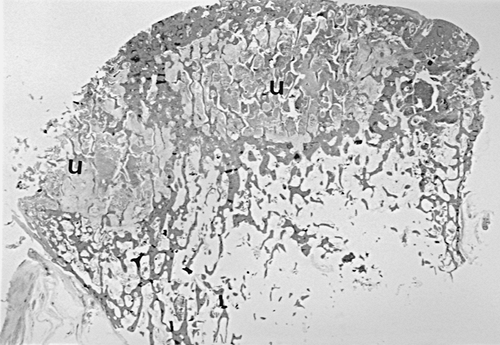 |
Figure 3-33 Whole mount coronal section of femoral head from adult man with severe secondary osteoarthritis due to recurrent gout. Large subchondral deposits of urate (u) and associated lipid are present. The joint surface shows marked eburnation, but osteophytes are inconspicuous. (Magnification x 2.) |
Calcium Oxalate Deposition Disease. This heterogeneous group of disorders is composed of heritable primary oxalosis172 and the much more common secondary variants associated with renal failure, intestinal bypass surgery, and chronic inflammatory bowel disease.173 Articular manifestations of oxalosis in chronic renal failure, the most common antecedent, are usually less prominent than the bone lesions and often must be distinguished from dialysis osteoarthropathy due to either secondary hyperparathyroidism or 2-microglobulin amyloid. Intracellular oxalate crystals are readily demonstrated by polarizing microscopy, but they are easily confused with CPPD crystals. Although large joints may be involved and the condition may be superimposed on existing osteoarthritis, involvement of the finger joints is characteristic.173 The condition is unlikely to be confused with uncomplicated generalized nodal osteoarthritis, however, because of the antecedent historical information and the associated multifocal lytic bone lesions.
Osteoarthritis with Synovium-Mediated Structural Alterations
Several types of acute or chronic synovial inflammatory diseases produce structural damage to bone and cartilage by means of inflammatory vascularized pannus formation. This ultimately results in cartilage erosion and bone remodeling often leading to secondary osteoarthritis. Rheumatoid arthritis is the most common disorder of this group, but the seronegative spondyloarthropathies174 as well as other miscellaneous disorders can create the destabilizing osteoarticular conditions that result in the superimposition of osteoarthritis on the preexisting inflammatory arthritis. This is particularly apparent when large weight-bearing joints such as femoral heads are removed for long-standing rheumatoid arthritis (Fig. 3-23). Eburnated bone with areas of fibrocartilage occupies the articular surface, and marked subchondral sclerosis may be present. Large osteophytes are absent. Similar changes may be seen in the large joints in other forms of chronic inflammatory arthritis if ankylosis does not supervene. Infectious arthropathies of several types also culminate in severe secondary osteoarthritis. Depending on the degree of residual bone and cartilage
P.68
deformity resulting from the infection, the affected joint or joints can assume bizarre configurations. In such cases, confusion with Charcot neuropathic arthropathy or destructive arthropathy associated with BCP or urate deposition is a possibility. Careful radiologic and pathologic studies can usually resolve the differential diagnosis.
Summary Concepts
The pathology of osteoarthritis gives insight into the pathogenesis of the disorder, as do several other fields of study. However, pathology in the clinical setting customarily views the morphologic changes only at one fixed point in time. Thus, the order in which events occurred, their dependency on one another, and their relative contributions to the final outcome can be difficult to discern. Nevertheless, the available pathologic evidence points to a multifactorial causation. Osteoarthritic cartilage lesions may result from heritable or acquired deficiencies in cartilage structural proteins, abnormal loading patterns, injury by inflammatory mediators, or changes in the underlying bone that result in decreased plasticity. Changes in the bone-cartilage interface and tidemark zones may also alter the metabolic state of the basal articular cartilage and result in ingress of cytokines and other mediators. Much of the obvious pathologic change of advanced osteoarthritis, such as eburnation, osteophytes, subchondral pseudocysts, secondary osteonecrosis, and detritic synovitis, is clearly reactive rather than etiologic. In some sites, such as the hands and possibly others as well, the genetic contribution to osteoarthritis may be dominant 86,89,90 although not exclusive.88,175 In others, such as the hips85,176 and the knees,177 strong environmental influences engendered by body weight 132 or occupation178 are clearly operative as well. Conflicting evidence regarding similar dichotomous theories accompanies experimentally induced arthritis in animals. The true impact of genetic predisposition to osteoarthritis is only beginning to become manifest through the application of molecular biology. Pathology has its limits because it deals primarily with the realm of that which has already happened. From this, one infers what would have transpired had the process continued. Thus, the pathologist is only a pundit who relies on personal or collective experience to predict relationships from a finite body of information. This is why rational explanation of the etiopathogenesis of osteoarthritis requires contributions from other fields to supplement pathologic findings.
References
1. Benedek TG. History of the rheumatic diseases. In: Klippel JH, ed. Primer on the Rheumatic Diseases. 11th ed. Atlanta, Arthritis Foundation, 1997, pp 1-5.
2. Sokoloff L. Some highlights in the emergence of modern concepts of osteoarthritis. Semin Arthritis Rheum 31:71 107, 2001.
3. Tarnopolsky S. Revision de la nomenclature rheumatologique. I. Les noms de Parthrose. Rev Rhum 17:497 500, 1950.
4. Heine J. ber die Arthritis deformans. Virchows Arch Pathol Anat 260:521 535, 1926.
5. Bennett GA, Waine H, Bauer W. Changes in the Knee Joint at Various Ages. New York, Commonwealth Fund, 1942.
6. Johnson LC, Kinetics of Osteoarthritis. Lab Invest 8:1223 1238, 1959.
7. Keuttner KE, Goldberg V, eds. Osteoarthritic Disorders. Rosemont, IL, American Academy of Orthopaedic Surgeons, 1995, pp 21-25.
8. Bonde HV, Talman MLM, Kofoed H. The area of the tidemark in osteoarthritis a three dimensional sterelogical study in 21 patients. APMIS 113:349 352, 2005.
9. Martin JA, Brown TD, Heiner AD, et al. Chrondrocyte senescence, joint loading and osteoarthritis. Clin Orthop Relat Res 427; Suppl: S96-103, 2004.
10. Sharif M, Whitehouse A, Sharan P, et al. Increased apoptosis in human osteoarthritic cartilage corresponds to reduced cell density and expression of caspase-3. Arthritis Rheum 50: 507-515, 2004.
11. Mitrovic DR, Riera H. Synovial, articular cartilage and bone changes in rapidly destructive arthropathy (osteoarthritis) of the hip. Rheumatol Int 12:17 22, 1992.
12. Gelse K, Soder S, Eger W, et al. Osteophyte development-molecular characterization of differentiation stages. Osteoarthritis Cartilage 11:141 148, 2003.
13. Mori S, Haruff R, Burr DB. Microcracks in the articular cartilage of human femoral heads. Arch Pathol Lab Med 117:196 198, 1993.
14. Fazzalari NL, Kuliwaba JS, Forword MR. Cancellous bone microdamage in the proximal femur: influence of age and osteoarthritis on damage morphology and regional distribution. Bone 31:697 702, 2002.
15. Dequeker J, Aerssens SJ, Luyten FP. Ostseoarthritis and ostseoporosis: Clinical and research evidence of inverse relationship. Aging Clin Exp Res 15: 426-439, 2003.
16. Hough AJ, Webber RJ. The pathology of the meniscus. Clin Orthop 252:32 40, 1990.
17. Mori Y, Kubo M, Okumo H, et al. Histological comparison of patellar cartilage degeneration between chondromalacia in youth and osteoarthritis in aging. Knee Surg Sports Traumatol Arthrosc 3:167 172, 1995.
18. Jensen DB, Albrektsen SB. The natural history of chondromalacia patellae. A 12-year follow-up. Acta Orthop Belg 56:503 506, 1990.
19. Zhang H, Kong XQ, Cheng C, et al. A correlative study between prevalence of chondromalacia patellae and sports injury in 4068 students. Clin J. Traumatol 6:370 374, 2004.
20. Lorenzo P, Bayliss MT, Hei egard D. Altered patterns and synthesis of extracellular matrix macromolecules in early osteoarthritis. Matrix Biol 23:381 391, 2004.
21. Curtin WA, Reville WJ. Ultrastructural observations on fibril profiles in normal and degenerative human articular cartilage. Clin Orthop 313:224 230, 1995.
22. Tchetina EV, Squires G, Poole AR. Increased type II collagen degradation and very early focal cartilage degeneration is associated with upregulation of chondrocyte differentiation related genes in early human articular cartilage lesions. J Rheumatol 32:876 886, 2005.
23. Misoge N, Hartmann M, Maelicke C, et al. Expression of collagen type I and type II in consecutive stages of human osteoarthritis. Histochem Cell Biol 122:229 236, 2004.
24. Walter H, Kawashima A, Nebelung W, et al. Immunohistochemical analysis of several proteolytic enzymes as parameters of cartilage degradation. Pathol Res Pract 194:73 81, 1998.
25. Chen MN, Wang JL, Wong CY, et al. Relationship of chondrocyte apoptosis to matrix degradation and swelling potential of osteoarthritis cartilage. J Formos Med Assoc 104:264 272, 2005.
26. Kouri JB, Jimenes SA, Quintero M, et al. Ultrastructural study of chondrocytes from fibrillated and non-fibrillated human osteoarthritic cartilage. Osteoarthritis Cartilage 4:111 125, 1996.
27. Rotzer A, Mohr W: 3H-thymidine incorporation into chondrocytes of arthritic cartilage [in German]. Z Rheumatol 51:172 176, 1992.
28. Macha N, Older J, Bitensky L, et al. Abnormalities of DNA in human osteoarthritic cartilage. Cell Biochem Funct 11:63 69, 1993.
29. Broberg K, Limon J, Palsson E, et al. Clonal chromosome aberrations are present in vivo in synovia and osteophytes from patients with osteoarthritis. Hum Genet 101:295 298, 1997.
P.69
30. Boos N, Nerlich AG, Wiest I, et al. Immunohistochemical analysis of type-X-collagen expression in osteoarthritis of the hip joint. J Orthop Res 17:495 502, 1999.
31. Konttinen YT, Ma J, Ruuttilal P, et al. Chrondrocyte-mediated collagenolysis correlates with cartilage destruction grades in osteoarthritis. Clin Exp Rheumatol 23:19 26, 2005.
32. Aigner T, Vornehm SI, Zeiler G, et al. Suppression of cartilage matrix gene expression in upper zone chondrocytes of osteoarthritic cartilage. Arthritis Rheum 40:562 569, 1997.
33. Imai K, Ohta S, Matsumoto T, et al. Expression of membrane-type I matrix metalloproteinase and activation of progelatinase A in human osteoarthritic cartilage. Am J Pathol 151:245 256, 1997.
34. Poole AR, Kobayashi M, Yasuda T, et al. Type II collagen degradation and its regulation in articular cartilage in osteoarthritis. Ann Rheum Dis 61:78 81, 2002.
35. Henrotin Y, Debert M, Dubuc JE, et al. Type II collagen peptides for measuring cartilage degradation. Biorheology 41:543 547, 2004.
36. Gebhard PM, Gehrsitz A, Bau B, et al. Quantification of expression levels of cellular differentiation markers does not support a general shift in the cellular phenotype of osteoarthritic chondrocytes. J Orthop Res 21:96 101, 2003.
37. Misoge N, Waletzko K, Bode C, et al. Light and electron microscopic in-situ hybridization of collagen type I and type II mRNA in the fibrocartilaginous tissue of late-stage osteoarthritis. Osteoarthritis Cartilage 6:278 285, 1998.
38. Soder S, Hambach L, Lissner R, et al. Ultrastructrual localization of type VI collagen in normal adult and osteoarthritic human articular cartilage. Osteoarthritis Cartilage 10:464 470, 2002.
39. Amir G, Pirie CJ, Rashad S, et al. Remodeling of subchondral bone in osteoarthritis: a histomorphometric study. J Clin Pathol 45:990 992, 1992.
40. Oegema TR, Carpenter RJ, Hofmeister F, et al. The interaction of the zone of calcified cartilage and subchondral bone in osteoarthritis. Microsc Res Tech 37:324 332, 1997.
41. Burr DB. Anatomy and physiology of the mineralized tissues: role in the pathogenesis of osteoarthrosis. Osteoarthritis Cartilage 12; Supp A: 520-530, 2004.
42. Tanaka E, Aoyama J, Miyauchi M., et al. Vascular endothelial growth factor plays an important autocrine/paracrine role in the progression of osteoarthritis. Histochem Cell Biol 123: 275-281, 2005.
43. Shibakawa A, Yudoh K, Masuko-Hongo K, et al. The role of subchondral resorption pits in osteoarthritis: MMP production by cells derived from bone marrow. Osteoarthritis Cartilage 13:679 687, 2005.
44. Dequeker J, Mokassa L, Aerssens J, et al. Bone density and local growth factors in generalized osteoarthritis. Microsc Res Tech 37:358 371, 1997.
45. Bobinac D, Spanjol J, Zoricic S, et al. Changes in articular cartilage and subchondral bone histomorphometry in osteoarthritic knee joints in humans. Bone 32:284 290, 2003.
46. Franchi A, Bullough PG. Secondary avascular necrosis in coxarthrosis: a morphologic study. J Rheumatol 19:1263 1268, 1992.
47. O'Connell JX, Nielsen GP, Rosenberg AE. Subchondral acute inflammation in severe arthritis: a sterile osteomyelitis? Am J Surg Pathol 23:192 197, 1999.
48. Sokoloff L. Microcracks in the calcified layer of articular cartilage. Arch Pathol Lab Med 117:191 195, 1993.
49. Burr DB, Radin EL. Microfractures and mircocracks in subchondral bone: are they relevant to osteoarthrosis? Rheum Dis Clin North Am 29:675 685, 2003.
50. Fassalari NL. Trabecular microfracture. Calcified Tissue Int 53 Suppl 1: 5143-5146, 1993.
51. Koszyca B, Fazzalari NL, Vernon-Roberts B. Microfractures in coxarthrosis. Acta Orthop Scand 61:307 310, 1990.
52. Ding M, Odgaarda A, Hvid I. Changes in the three-dimensional microstructure of human tibial cancellous bone in early osteoarthritis. J Bone Joint Surg Br. 85:906 912, 2003.
53. Fazzalari NL, Parkinson IH. Fractal properties of subchondral cancellous bone in severe osteoarthritis of the hip. J Bone Miner Res 12:632 640, 1997.
54. Dorr HD, Martin H, Pellengahr C, et al. The cause of subchondral bone cysts in osteoarthrosis: a finite element analysis. Acta Orthop Scand. 75:554 558, 2004.
55. Neuman P, Hulth A, Linden B, et al. The role of osteophytic growth in hip osteoarthritis. Int Orthop 27:262 266, 2003.
56. Martel-Pelletier J, DiBattista JA, Lejeunesse D, et al. IGF/IGFBP axis in cartilage and bone in osteoarthritis pathogenesis. Inflamm Res 47:90 100, 1998.
57. Fernandes JC, Martel-Pelletier J, Pelletier JP. The role of cytokines in osteoarthritis pathophysiology. Biorheology 39:237 246, 2002.
58. Haywood L, McWilliams DF, Pearson CI, et al. Inflammation and angiogenesis in osteoarthritis. Arthritis Rheum 48:2173 2177, 2003.
59. Ayral X, Pickering EH, Woodworth TG, et al. Synovitis: a potential predictive factor of structural progression of medial tibiofemoral knee osteoarthritis results of a 1 year longitudinal arthroscopic study in 422 patients. Osteoarthritis Cartilage 13:361 367, 2005.
60. Dijkgraaf LC, Liem RS, de Bont LG. Ultrastructural characteristics of the synovial membrane in osteoarthritic temporomandibular joints. J Oral Maxillofac Surg 55:1269 1279, 1997.
61. Goldenberg DL, Egan MS, Cohen AS. Inflammatory synovitis in degenerative joint disease. J Rheumatol 9:204 209, 1982.
62. Schulte E, Fisseler-Eckhoff A, Muller KM. Differential diagnosis of synovitis. Correlation of arthroscopic-biopsy to clinical findings [in German]. Pathologie 15:22 27, 1994.
63. Demarziere A. Macrophages in rheumatoid synovial membrane: an update [in French]. Rev Rhum Ed Fran 60:568 579, 1993.
64. Ezawa K, Yamamura M, Matsui H, et al. Comparative analysis of CD45RA- and CD45RO-positive CD4 T cells in peripheral blood, synovial fluid, and synovial tissue in patients with rheumatoid arthritis and osteoarthritis. Acta Med Okayama 51:25 31, 1997.
65. Spector TD, Hart DJ, Nandra D, et al. Low-level increases in serum C-reactive protein are present in early osteoarthritis of the knee and predict progressive disease. Arthritis Rheum 40:723 733, 1997.
66. Fort JG, Flanigan M, Smith JB. Mononuclear cell (MNC) subtypes in osteoarthritis synovial fluid. J Rheumatol 22:1335 1337, 1995.
67. Pu J, Nishida K, Inoue H, et al. Mast cells in osteoarthritic and rheumatoid arthritic synovial tissues of the human knee. Acta Med Okayama 52:35 39, 1998.
68. Smith MD, Triantafillou S, Parker A, et al. Synovial membrane inflammation and cytokine production in patients with early osteoarthritis. J Rheumatol 24:365 371, 1997.
69. Myers SL, Flusser D, Brandt KD, et al. Prevalence of cartilage shards and their association with synovitis in patients with early and endstage osteoarthritis. J Rheumatol 19:1247 1251, 1992.
70. Garnero P, Mazieres B, Gueguen A, et al. Cross-sectional association of 10 molecular markers of bone, cartilage, and synovium with disease activity and radiological joint damage in patients with hip osteoarthritis: ECHODIAH cohort. J Rheumatol 32:697 703, 2005.
71. Vetto AA, Mannik M, Zatarain-Rios E, et al. Immune deposits in articular cartilage of patients with rheumatoid arthritis have a granular pattern not seen in osteoarthritis. Rheumatol Int 10:13 20, 1990.
72. Du H, Masuko-Hongo K, Nakamura H, et al. The prevalence of autoantibodies against cartilage intermediate layer protein, YKL-39, osteopontin, and cyclic citrullinated peptide in patients with early-stage knee osteoarthritis: evidence of a variety of autoimmune processes. Rheumatol Int 26:35 41, 2004.
73. Cheung HS. Role of calcium-containing crystals in osteoarthritis. Front Biosci 10:1336 1340, 2005.
74. Webb GR, Westacott CI, Elson CJ. Chondrocyte tumor necrosis factor receptors and focal loss of cartilage in osteoarthritis. Osteoarthritis Cartilage 5:427 437, 1997.
75. Van Linthoudt D, Beutler A, Clayburne G, et al. Morphometric studies on synovium in advanced osteoarthritis: Is there an association between apatite-like material and collagen deposits? Clin Exp Rheum 15:493 497, 1997.
76. Sokoloff L, Varma AA. Chondrocalcinosis in surgically resected joints. Arthritis Rheum 31:750 756, 1988.
P.70
77. Lanzer WL, Komenda G. Changes in articular cartilage after meniscectomy. Clin Orthop 252:41 48, 1990.
78. Abe M, Takahashi M, Naitou K, et al. Investigation of generalized osteoarthritis by combining x-ray grading of the knee, spine, and hand using biochemical markers for arthritis in patients with knee ostseoarthritis. Clin Rheumatol 22:425 431, 2003.
79. Sokoloff L, DiFrancesco L. Lipochondral degeneration of capsular tissue in osteoarthritic hips. Am J Surg Pathol 19:278 283, 1995.
80. Ladefoged C, Merrild V, Jorgensen B. Amyloid deposits in surgically removed articular and periarticular tissue. Histopathology 15:289 296, 1989.
81. Athanasou NA, Sallie B. Localized deposition of amyloid in articular cartilage. Histopathology 20:41 46, 1992.
82. Beighton PM, De Paepe A, Hall JG, et al. Molecular nosology of heritable disorders of connective tissue. Am J Med Genet 42:431 438, 1992.
83. De Paepe A. Heritable collagen disorders: from phenotype to genotype. Verh K Acad Geneeskd Belg 60:463 482, 1998.
84. Irlenbusch U, Dominic G. [Examination of Heberden arthrosis with a histological-histochemical score]. Z Orthop Ihre Grenzgeb 137:355 361, 1999.
85. Vingard E, Alfredsson L, Malchau H. Osteoarthrosis of the hip in women and its relation to physical load at work and in the home. Ann Rheum Dis 56:293 298, 1997.
86. Hirsch R, Lethbridge-Cejku M, Hanson R, et al. Familial aggregation of osteoarthritis: data from the Baltimore Longitudinal Study on Aging. Arthritis Rheum 41:1227 1232, 1998.
87. Englund M, Paradowski PT, Lohmander LS. Association of radiographic hand osteoarthritis with radiographic knee osteoarthritis after meniscectomy. Arthritis Rheum 50: 469-475, 2004.
88. Solovieva S, Vehmas T, Riihimaki H, et al. Hand use and patterns of joint involvement in osteoarthritis. A comparison of female dentists and teachers. Rheumatol (Oxford) 44:521 528, 2005.
89. Doherty M. Genetics of hand osteoarthritis. Osteoarthritis Cartilage 8, Suppl A: 508-510, 2000.
90. Felson DT, Couropmitree NN, Chaisson CE, et al. Evidence for a Mendelian gene in a segregation analysis of generalized radiographic osteoarthritis: the Framingham study. Arthritis Rheum 41:1064 1071, 1998.
91. Reginato AJ, Passolno GM, Neumann G, et al. Familial spondyloepiphyseal dysplasia tarda, brachydactyly, and precocious osteoarthritis associated with an arginine 75 cysteine mutation in the procollagen type II gene in a kindred of Chiloe Islanders. I. Clinical, radiographic, and pathologic findings. Arthritis Rheum 37:1078 1086, 1994.
92. Pun YL, Moskowitz RW, Lie S, et al. Clinical correlations of osteoarthritis associated with a single-base mutation (arginine 519 to cysteine) in type II procollagen gene. A newly defined pathogenesis. Arthritis Rheum 37:264 269, 1994.
93. Vikkula M, Palotie A, Rituaniemi P, et al. Early onset osteoarthritis linked to the type II procollagen gene. Detailed clinical phenotype and further analyses of the gene. Arthritis Rheum 36:401 409, 1993.
94. Lieberfarb RM, Levy HP, Rose PS, et al. The Stickler syndrome: genotype/phenotype correlation in 10 families with Stickler syndrome resulting from seven mutations in the type II collagen gene locus COL2A1. Genet Med 5:21 27, 2003.
95. Bleasel JF, Bisagni-Faure A, Holderbaum D, et al. Type II procollagen gene (COL2A1) mutation in exon 11 associated with spondyloepiphyseal dysplasia, tall stature, and precocious osteoarthritis. J Rheumatol 22:255 261, 1995.
96. Jakkula E, Melkoniemi M, Kiuinanta I. et al. The role of sequence variations within the genes encoding collagen II, IX, and XI in non-syndromic, early-onset osteoarthritis. Osteoarthritis Cartilage 13:497 507, 2005.
97. Loughlin J. The genetic epidemiology of human primary osteoarthritis: current status. Expert Rev Mol Med 7:1 12, 2005.
98. Mathieu F, Begaux F, Lan ZY, et al. Clinical manifestations of Kashin-Beck disease in Nyemo Valley, Tibet. Int Orthop 21: 151-156, 1997.
99. Ballo R, Viljoen D, Machado M. et al. Mseleni joint disease a molecular genetic approach to defining the etiology. S Afr Med J 86: 956-958. 1996.
100. Agarwal SS, Phadke SR, Fredlund V, et al. Mseleni and Handigodu familial osteoarthropathies: syndromic identity? Am J Med Genet 72:435 439, 1997.
101. Sokoloff L. Endemic forms of osteoarthritis. Clin Rheum Dis 11:187 202, 1985.
102. Pasteels JL, Liu FD, Hinsenhamp M, et al. Histology of Kashin-Beck lesions. Int Orthop 25:151 153, 2001.
103. Wang SJ, Guo X, Zuo H, et al. [Chondrocyte apoptosis and the expression of Bcl-2, Bax, Fas and Inos in articular cartilage in Kashin-Beck disease]. Di YI, Jun YI, Da Xue, Xue Bao. 25:643 646, 2005.
104. Yang GQ, Xia YM. Studies on human dietary requirements and safe range of dietary intakes of selenium in China and their application in the prevention of related endemic diseases. Biomed Environ Sci 8:187 201, 1995.
105. Moreno-Reyes R, Mathieu F, Boelaert M, et al. Selenium and iodine supplementation of rural Tibetan children affected by Kashin-Beck osteoarthropathy. Am J Clin Nutr 78:137 144, 2003.
106. Zhang WH, Neve J, Xu JP, et al. Selenium, iodine, and fungal contamination in Yulin District (People's Republic of China) endemic for Kashin-Beck disease. Int Orthop 25:188 190, 2001.
107. Yang C, Niu C, Bodo M, et al. Fulvic acid supplementation and selenium deficiency disturb the structural integrity of mouse skeletal tissue. An animal model to study the molecular effects of Kashin-Beck disease. Biochem J 289:829 835, 1993.
108. Liang HJ, Tsai CL, Lu FJ. Oxidative stress induced by humic acid solvent extraction fraction in cultured rabbit articular chondrocytes. J Toxicol Environ Health 54:477 489, 1998.
109. Sokoloff L, Fincham JE, du Toit GT. Pathological features of the femoral head in Mseleni disease. Hum Pathol 16:117 120, 1985.
110. Schnitzler CM, Pieczkowski WM, Fredlund V, et al. Histomorphometric analysis of osteopenia associated with endemic osteoarthritis (Mseleni joint diease). Bone 9:21 27, 1988.
111. Viljoen D, Fredlund V, Ramesar R, et al. Brachydactylous dwarfs of Mseleni. Am J Med Genet 46:636 640, 1993.
112. Derfus BA, Kurian JB, Butler JJ, et al. The high prevalence of pathologic calcium crystals in preoperative knees. J Rheumatol 29:570 574, 2002.
113. Giunta C, Superti-Furga A, Spranger S, et al. Ehlers-Danlos syndrome type VII: clinical features and molecular defects. J Bone Joint Surg Am 81:225 238, 1999.
114. Zweers MC, Dean WB, Van Kuppevelt TH, et al. Elastic fiber abnormalities in hypermobility type Ehler-Danlos syndrome patients with tenascin-x mutations. Clin Genet 67:330 334, 2005.
115. Badelon O, Bensahel H, Csukonyi Z, et al. Congenital dislocation of the hip in Ehlers-Danlos syndrome. Clin Orthop 255:138 143, 1990.
116. Roughley PJ, Rauch F, Glorieux FH. Osteogenesis imperfecta clinical and molecular diversity. Eur Cell Mater 30: 41-47, 2003.
117. Vujic M, Hallstensson, Wahlstrom J, et al. Localization of a gene for autosomal dominant Larsen syndrome to chromosome region 3p 21.1 14.1 in the proximity of, but distinct from, the COL7A1 locus. Am J Hum Genet 57:1104 1113, 1995.
118. Meabuchi A, Haga N, Maeda K, et al. Novel and recurrent mutations clustered in von Willebrand factor A domain of MA7N3 in multiple epiphyseal dysplasia. Human Mutat 24:439 440, 2004.
119. Jakkula E, Makitie O, Czarny-Ratacjzak M, et al. Mutations in the known genes are not the major cause of MED; distinctive phenotypic entities among patients with no identified mutations. Eur J Hum Genet 13:292 301, 2005.
120. Melis M, Onori P, Aliberti G, et al. Ochronotic arthropathy: structural and ultrastructural features. Ultrastruct Pathol 18:467 471, 1994.
121. Hiraku Y, Yamasaki M, Kawanishi S. Oxidative DNA damage induced by homogentisic acid, a tyrosine metabolite. FEBS Lett 432:13 16, 1998.
122. Roosendaal G, van Rinsum AC, Vianen ME, et al. Haemophilic arthropathy resembles degenerative rather than inflammatory joint disease. Histopathology 34:144 153, 1999.
123. Roosendaal G, Lafeber FP. Blood-induced joint damage in hemophilia. Semin Thromb Hemost 29:37 42, 2003.
P.71
124. Ito H, Matsuno T, Kaneda K. Prognosis of early stage avascular necrosis of the femoral head. Clin Orthop 358:149 157, 1999.
125. Van der Schoot DK, den Outer AJ, Bode PJ, et al. Degenerative changes at the knee and ankle related to malunion of tibial fractures: 15-Year follow-up of 88 patients. J Bone Joint Surg Br 78:722 725, 1996.
126. Jacobsen S, Sonne-holm S. Hip dysplasia; a significant risk factor for development of hip osteoarthritis. A cross-sectional survey. Rheumatology (Oxford) 44:211 218, 2005.
127. Helliwell PS. Osteoarthritis and Paget's disease. Br J Rheumatol 34:1061 1063, 1995.
128. Crispin JC, Alcocer-Varela J. Rheumatologic manifestations of diabetes mellitus. Am J Med 114: 753-757, 2003.
129. Cimmino MA, Cutolo M. Plasma glucose concentration in symptomatic osteoarthritis: a clinical and epidemiological survey. Clin Exp Rheumatol 8:251 257, 1990.
130. Frey MI, Barrett-Connor E, Sledge PA, et al. The effect of noninsulin dependent diabetes mellitus on the prevalence of clinical osteoarthritis. A population based study. J Rheumatol 23: 716-722, 1996.
131. Senolt L, Braun M, Olejarova M, et al. Increased pentosidine, an advanced glycation end product in serum and synovial fluid from patients with knee osteoarthritis and its relation with cartilage oligomeric matrix protein. Ann Rheum Dis 64:886 890, 2005.
132. Holmberg S, Thelin A, Thelin N. Knee osteoarthritis and body mass index: a population-based case-control study. Scand J. Rheumatol 34:59 64, 2005.
133. Cerhan JR, Wallace RB, el-Khoury GY, et al. Decreased survival with increasing prevalence of full-body radiographically defined osteoarthritis in women. Am J Epidemiol 141:225 234, 1995.
134. Lieberman SA, Bjorkengren AG, Hoffman AR. Rheumatologic and skeletal changes in acromegaly. Endocrinol Metab Clin North Am 21:615 631, 1992.
135. Denko CW, Boja B, Moskowitz RW. Growth promoting peptides in osteoarthritis and diffuse idiopathic skeletal hyperostosis insulin, insulin-like growth factor I, growth hormone. J Rheumatol 21:1725 1730, 1994.
136. Wikinson JA. Etiologic factors in congenital displacement of the hip and myelodysplasia. Clin Orthop 281:75 83, 1992.
137. Uden A, Lindhagen T. Inguinal hernia in patients with congenital hip dislocation. Acta Orthop Scand 59:667 668, 1988.
138. Hoaglund FT, Healey JH. Osteoarthrosis and congenital dysplasia of the hip in family members of children who have congenital dysplasia of the hip. J Bone Joint Surg Am 72:1510 1518, 1990.
139. Jacobsen S, Sonne-Holm S, Soballe K, et al. Hip dysplasia and osteoarthrosis: a survey of 4151 subjects from the Osteoarthrosis Substudy of the Copenhagen City Heart Study. Acta Orthop 76:149 158, 2005.
140. Lane NE, Neuitt MC, Cooper C, et al. Acetabular dysplasia and osteoarthritis of the hip in elderly white women. Ann Rheum Dis 56:627 630, 1997.
141. Guille JT, Lipton GE, Szoke G, et al. Legg-Calv -Perthes disease in girls. A comparison of the results with those seen in boys. J Bone Joint Surg Am 80:1256 1263, 1998.
142. Hochbergs P, Eckerwall G, Egund N, et al. Synovitis in Legg-Calv -Perthes disease. Evaluation with MR imaging in 84 hips. Acta Radiol 39:532 537, 1998.
143. Arruda VR, Belangero WD, Ozelo MC, et al. Inherited risk factors for thrombophilia among children with Legg-Calv -Perthes disease. J Pediatr Orthop 19:84 87, 1999.
144. Poussa M, Schlenzka D, Yrjonen T. Body mass index and slipped capital femoral epiphysis. J Pediatr Orthop B 12:369 371, 2003.
145. Stasikelis PJ, Sullivan CM, Phillips WA, et al. Slipped capital femoral epiphysis. Prediction of contralateral involvement. J Bone Joint Surg Am 78:1149 1155, 1996.
146. Docquier PL, Mousny M, Jouret M, et al. Orthopedic concerns in children with growth hormone therapy. Acta Orthop Belg 70:299 305, 2004.
147. Goodman DA, Feighan JE, Smith AD, et al. Subclinical slipped capital femoral epiphysis. Relationship to osteoarthrosis of the hip. J Bone Joint Surg Am 79:1489 1497, 1997.
148. Baldwin CT, Farrer LA, Adair R, et al. Linkage of early-onset osteoarthritis and chondrocalcinosis to human chromosome 8q. Am J Hum Genet 56:692 697, 1995.
149. Pereira ER, Brown RR, Resnick D. Prevalence and patterns of tendon calcifications in patients with chondrocalcinosis of the knee: radiographic study of 156 patients. Clin Imaging 22:371 375, 1998.
150. Zhang Y, Johnson K, Russell RG, et al. Association of sporadic chondrocalcinosis with a 4-basepair G-to-A transition in the 5-untranslated region of ANKH that promotes enhanced expression of ANKH protein and excess generation of extracellular inorganic pyrophosphate. Arthritis Rheum 52:1110 1117, 2005.
151. Zhang W, Neame R, Doherty S, et al. Relative risk of knee chondrocalcinosis in siblings of index cases with pyrophosphate arthropathy. Ann Rheum Dis 63:969 973, 2004.
152. Cardenal A, Masuda I, Ono W, et al. Serum nucleotide pyrophosphatase activity; elevated levels in osteoarthritis, calcium pyrophosphate crystal deposition disease, scleroderma, and fibromyalgia. J Rheumatol 25:2175 2180, 1998.
153. Hashimoto S, Ochs RL, Rosen F, et al. Chondrocyte-derived apoptotic bodies and calcification of articular cartilage. Proc Natl Acad Sci USA 95:3094 3099, 1998.
154. Swan A, Chapman B, Heap P, et al. Submicroscopic crystals in osteoarthritic synovial fluids. Ann Rheum Dis 53:467 470, 1994.
155. Axford JS, Bomford A, Revell P, et al. Hip arthropathy in genetic hemochromatosis. Radiographic and histologic features. Arthritis Rheum 34:357 361, 1991.
156. Kramer U, Weinberger A, Yarom R, et al. Synovial copper deposition as a possible explanation of arthropathy in Wilson's disease. Bull Hosp Jt Dis 52:46 49, 1993.
157. Sequeira W. The neuropathic joint. Clin Exp Rheumatol 12: 325-327, 1994.
158. Ines LS, Da Silva JA, Mealcata AB, et al. Arthropathy of genetic hemochromatosis: a major and distinctive manifestation of the disease. Clin Exp Rheumatol 19:98 102, 2001.
159. Timms AE, Sathananthan R, Bradbury L, et al. Genetic testing for haemochromatosis in patients with chondrocalcinosis. Ann Rheum Dis. 61: 745-747, 2002.
160. Cauza E, Hanusch-Enserer U, Etemad M, et al. HFE genotyping demonstrates a significant indcidence of hemochromatosis in undifferentiated arthritis. Clin Exp Rheumatol 23:7 12, 2005.
161. Halverson PB, McCarty DJ. Patterns of radiographic abnormalities associated with basic calcium phosphate and calcium pyrophosphate dihydrate crystal deposition in the knee. Ann Rheum Dis 45:603 605, 1986.
162. Molloy ES, McCarthy GM. Hydroxyapatite deposition disease of the joint. Curr Rheumatol Rep 5:215 221, 2003.
163. Ea HK, Uzan B, Rey C, et al. Octacalcium phosphate crystals directly stimulate expression of inducible nitric oxide synthase through p38 and JNK mitogen-activated protein kinases in articular chondrocytes. Arthritis Res Ther 7:R915-R926, 2005.
164. Vignon E, Balblanc JC, Mathieu P, et al. Metalloprotease activity, phospholipase A2 activity and cytokine concentration in osteoarthritis synovial fluids. Osteoarthritis Cartilage 1:115 120, 1993.
165. Choi HK, Mount DB, Reginato AM. Pathogenesis of gout. Ann Int Med 143: 499-518, 2005.
166. Brancroft JD, Stevens A. Theory and Practice of Histological Techniques. 3rd ed. Edinburgh, Churchill Livingstone, 1990, pp 262-263.
167. Pascual E. Persistence of monosodium urate crystals and low grade inflammation in the synovial fluid of patients with untreated gout. Arthritis Rheum 34:141 145, 1991.
168. Fam AG, Stein J, Rubenstein J. Gouty Arthritis in nodal osteoarthritis. J Rheumatol 23:684 689, 1996.
169. Jaccard YB, Gerster JC, Calame L. Mixed monosodium urate and calcium pyrophosphate crystal-induced arthropathy. A review of seventeen cases. Rev Rhum Engl Ed 63:331 335, 1996.
170. Yu KH, Luo SF, Liou LB, et al. Concomitant septic and gouty arthritis an analysis of 30 cases. Rheumatology (Oxford) 42:1062 1066, 2003.
171. Ishida T, Dorfman HD, Bullough PG. Tophaceous pseudogout (tumoral calcium pyrophosphate dihydrate crystal deposition disease). Hum Pathol 26:587 593, 1995.
172. Milliner S. The primary hyperoxalurias: an algorithm for diagnosis. Am J Nephrol 25:154 160, 2005.
173. Maldonado I, Prasad V, Reginato AJ. Oxalate crystal deposition disease. Current Rheumatol Rep 4:257 264, 2002.
P.72
174. Torii H, Nakagawa H, Ishibashi Y. Osteoarthritis in 84 Japanese patients with palmoplantar pustulosis. J Am Acad Dermatol 31:732 735, 1994.
175. Verrouil E, Mazieres B. Etiologic factors in finger osteoarthritis. Rev Rhum Engl Ed 62(suppl):95 135, 1995.
176. Roach KE, Persky V, Miles T, et al. Biomechanical aspects of occupation and osteoarthritis of the hip: a case-control study. J Rheumatol 21:2334 2340, 1994.
177. Spector TD, Hart DJ, Doyle DV. Incidence and progression of osteoarthritis in women with unilateral knee disease in the general population: the effect of obesity. Ann Rheum Dis 53:565 568, 1994.
178. Maetzel A, Makela M, Hawker G, et al. Osteoarthritis of the hip and knee and mechanical occupational exposure a systematic overview of the evidence. J Rheumatol 24:1599 1607, 1997.
EAN: 2147483647
Pages: 19
- Using SQL Data Manipulation Language (DML) to Insert and Manipulate Data Within SQL Tables
- Using Data Control Language (DCL) to Setup Database Security
- Creating Indexes for Fast Data Retrieval
- Performing Multiple-table Queries and Creating SQL Data Views
- Working with Comparison Predicates and Grouped Queries